When you hear the term ‘Snake Plant’ there may be more than one type of plant that comes to mind.
The moniker is often used to describe more than one type of Sansevieria, or there are several sansevieria varieties, so it can be a little misleading if you’re referring to a specific plant. To add to the confusion, some species can also be found in a variety of different cultivars with vastly different appearances.
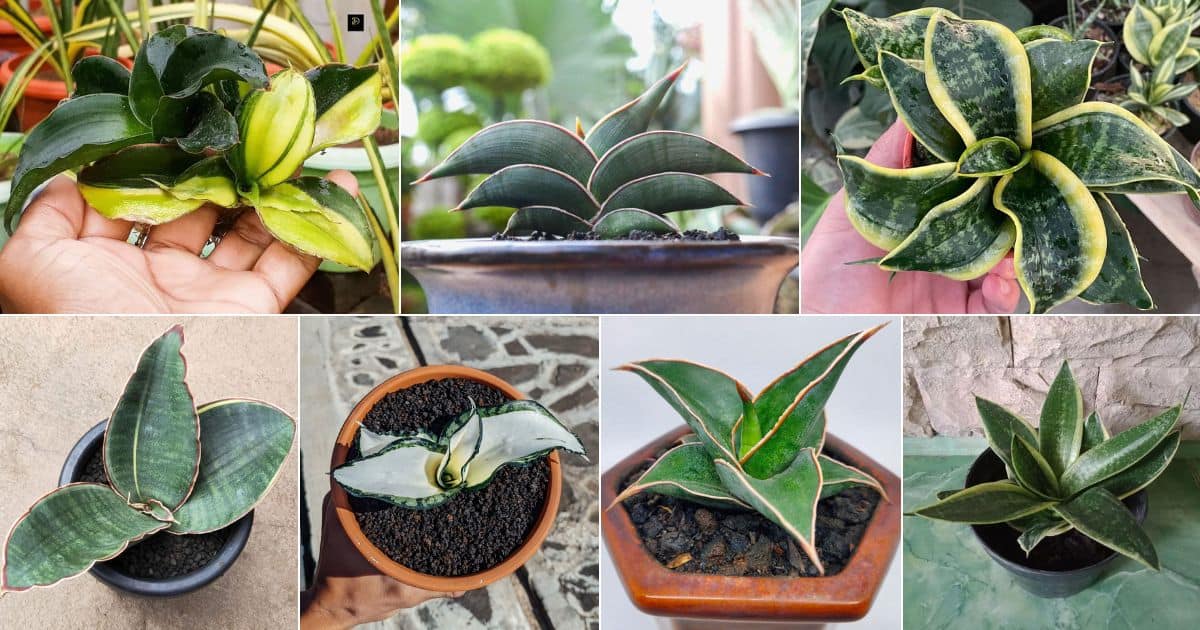
Did you know that there are over 70 species of snake plants? Before I began my succulent journey, I had come into contact with a lot of different snake plants. In my naivete, I didn’t realize that the genus sansevieria is a type of rhizomatic succulent.
What this means is that the plants and leaves grow from a main root and don’t branch like other succulents do. It’s an interesting concept regarding succulents: most of them have a main root or sometimes a caudex. Rhizomatic means that there are rhizomes or small sections of roots that grow off of one another. Each rhizome produces a single leaf or several leaves in a rosette-like pattern.
While this list doesn’t cover all of the species of snake plants, it does cover more than you have been able to see before. Most lists stop in the thirties, but here at Sublime Succulents, you know we always go that extra mile
Read Article: 9 Best Miniature Succulents
Jump to:
- Snake Plants Caring Tips
- Best Climate Conditions for Snake Plants
- Optimal Watering
- Optimal Light
- Sansevieria (Snake) Plant Varieties
- 1. Sansevieria arbborescens
- 2. Sansevieria trifazciata - Bantel’s Sensation
- 3. Sansevieria Black Dragon
- 4. Sansevieria Boncel Mini
- 5. Sansevieria Boncel variegated
- 6. Sansevieria canaliculate
- 7. Sansevieria Cleopatra
- 8. Sansevieria cylindrica
- 9. Sansevieria Ernestii
- 10. Sansevieria Fernwood
- 11. Sansevieria fischeri
- 12. Sansevieria futura robusta
- 13. Sansevieria gold flame
- 14. Sansevieria golden wendy
- 15. Sansevieria gracilis
- 16. Sansevieria grandis
- 17. Sansevieria green hahnii
- 18. Sansevieria guineensis variegate
- 19. Sansevieria hahnii jade
- 20. Sansevieria kirkii coppertone
- 21. Sansevieria Lady gaga
- 22. Sansevieria Macrophylla
- 23. Sansevieria masoniana
- 24. Sansevieria Masoniana variegate
- 25. Sansevieria Marginata
- 26. Sansevieria Metallica
- 27. Sansevieria Moonshine
- 28. Sansevieria Obake
- 29. Sansevieria Oncel Rhino
- 30. Sansevieria patens
- 31. Sansevieria Pearsonii
- 32. Sansevieria Rorida
- 33. Sansevieria Royal crown
- 34. Sansevieria Samurai dwarf
- 35. Sansevieria Samurai dwarf variegated
- 36. Sansevieria Scimitariformis
- 37. Sansevieria Siam gold
- 38. Sansevieria Siam silver
- 39. Sansevieria Silver nymph
- 40. Sansevieria Star canary
- 41. Sansevieria Subspicata variegated
- 42. Sansevieria Suffruticosa
- 43. Sansevieria trifasciata
- 44. Sansevieria Trifasciata gold hahnii
- 45. Sansevieria trifasciata ‘Laurentii’
- 46. Sansevieria Twist
- 47. Sansevieria Whitney
- 48. Sansevieria Zaznibarica robusta
- 49. Sansevieria Zeylanica
- Snake Plant Buying Guide
- Snake Plant FAQ:
- Conclusion
Snake Plants Caring Tips
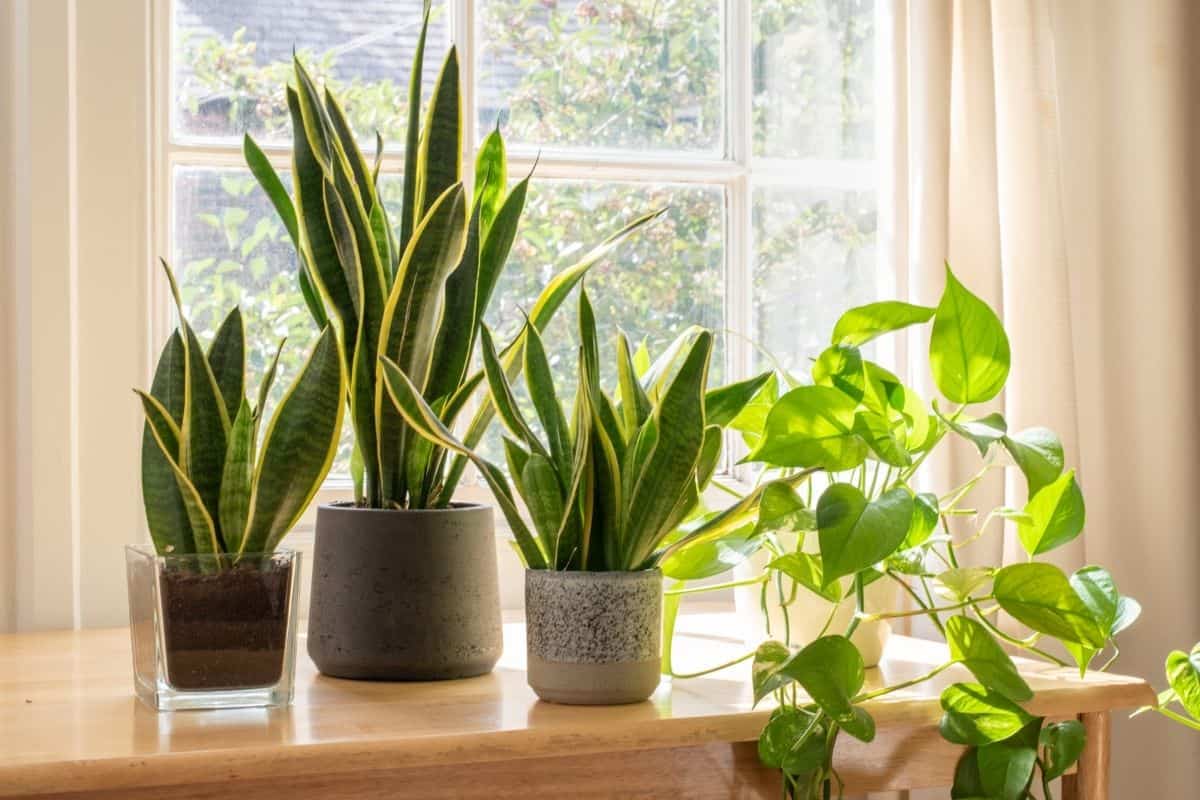
Caring for snake plants is very easy, in fact, it is like caring for most succulent species. When cared for correctly, snake plants grow rapidly, and they are ideal plants for propagation.
Due to the shape of their large, flat leaves, they will gather dust very easily and begin to look very unaesthetic if they are not dusted down regularly. You must be careful while doing this to ensure you don’t damage the leaves and cause scarring.
Sansevieria varieties are very tolerant and resistant to most pests and diseases. It is best practice to check your plant’s leaves, root system, and soil for any signs of pests or diseases.
You should also be aware that regular potting soil is not suitable for snake plant species as the soil is far too dense for these plants to thrive. Instead, pot them in cactus or succulent soil that is porous with great drainage to stop the roots from suffocating.
Best Climate Conditions for Snake Plants
Snake plants can live in most conditions as long as the temperature never reaches below 50°F (10°C). They make great houseplants, and they are also lovely plants to have in your backyard.
Never leave your plant in frosty conditions, as it will deteriorate very quickly. If your plant is situated on a balcony or in your backyard and the weather takes a turn for the worst, you must move snake plant varieties indoors for protection.
Optimal Watering
It can be very challenging to water your snake plant correctly. Overwatering is the most common succulent plant problem that growers all over the world face.
Watering your plant from the base is recommended. This helps the roots grow deep into the pot; it also helps you avoid flooding the roots as any excess water can be tipped out.
Use the ‘soak and dry’ method of watering for your succulent plant. Touch the soil every day and only water the plant if the soil is completely dry. This is very important as premature watering will lead to root rot and similar diseases.
Optimal Light
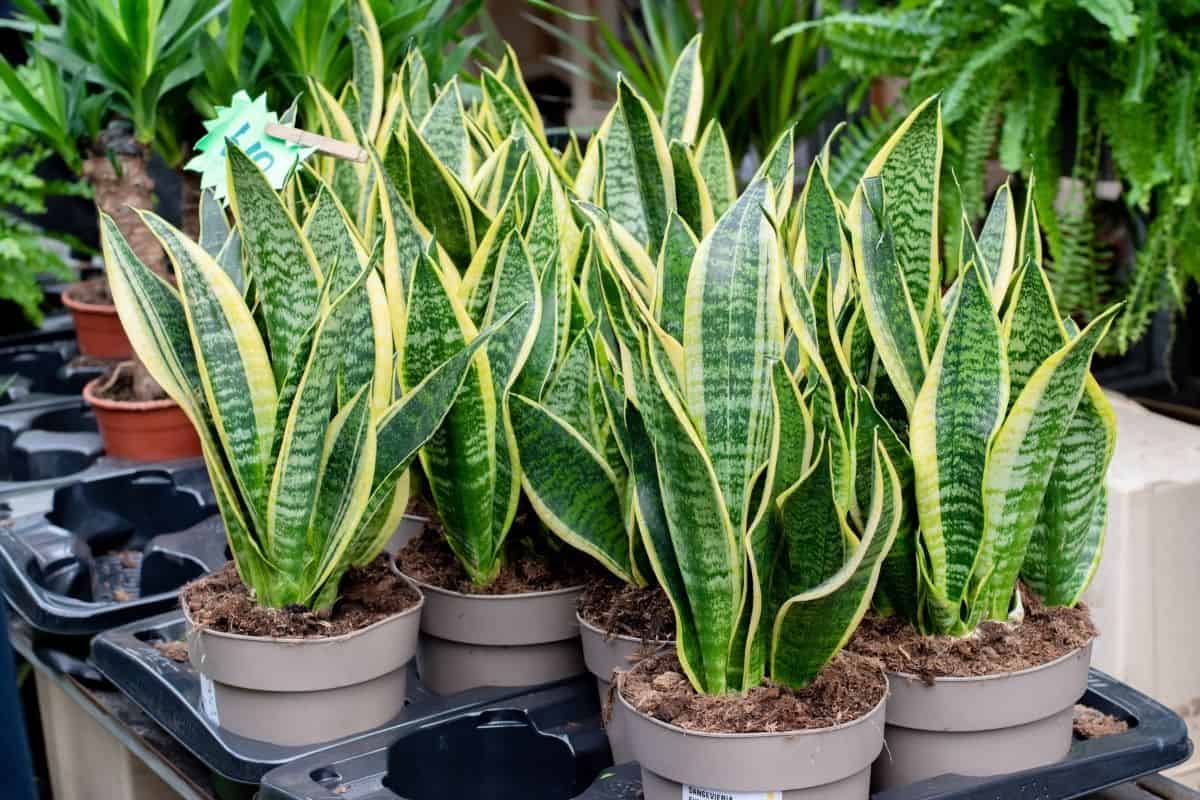
If you want your snake plant to grow rapidly, place it in a sunny corner of the house, in partial or indirect sunlight. Likewise, if you want your plant to grow slower, place them in a shaded area that gets some sunlight during the day.
Leaving your succulent in direct sunlight for long periods of time can be very detrimental. Its leaves may become brittle, they may split, and permanent scarring can develop that will not go away unless you trim and remove the damaged areas.
No products found.
Top Tip: You should always plant your snake plant in pots rather than in large containers that can’t be moved around. This is so that you can control the plant’s environment at all times.
Sansevieria (Snake) Plant Varieties
In all, there are over 70 types of Sansevieria that have been given the name ‘Snake Plant’.
Whether you already have Snake Plants in your collection or are considering your options, you have plenty of plants to choose from. Here are 49 Sansevieria that every Snake Plant lover should consider.
1. Sansevieria arbborescens
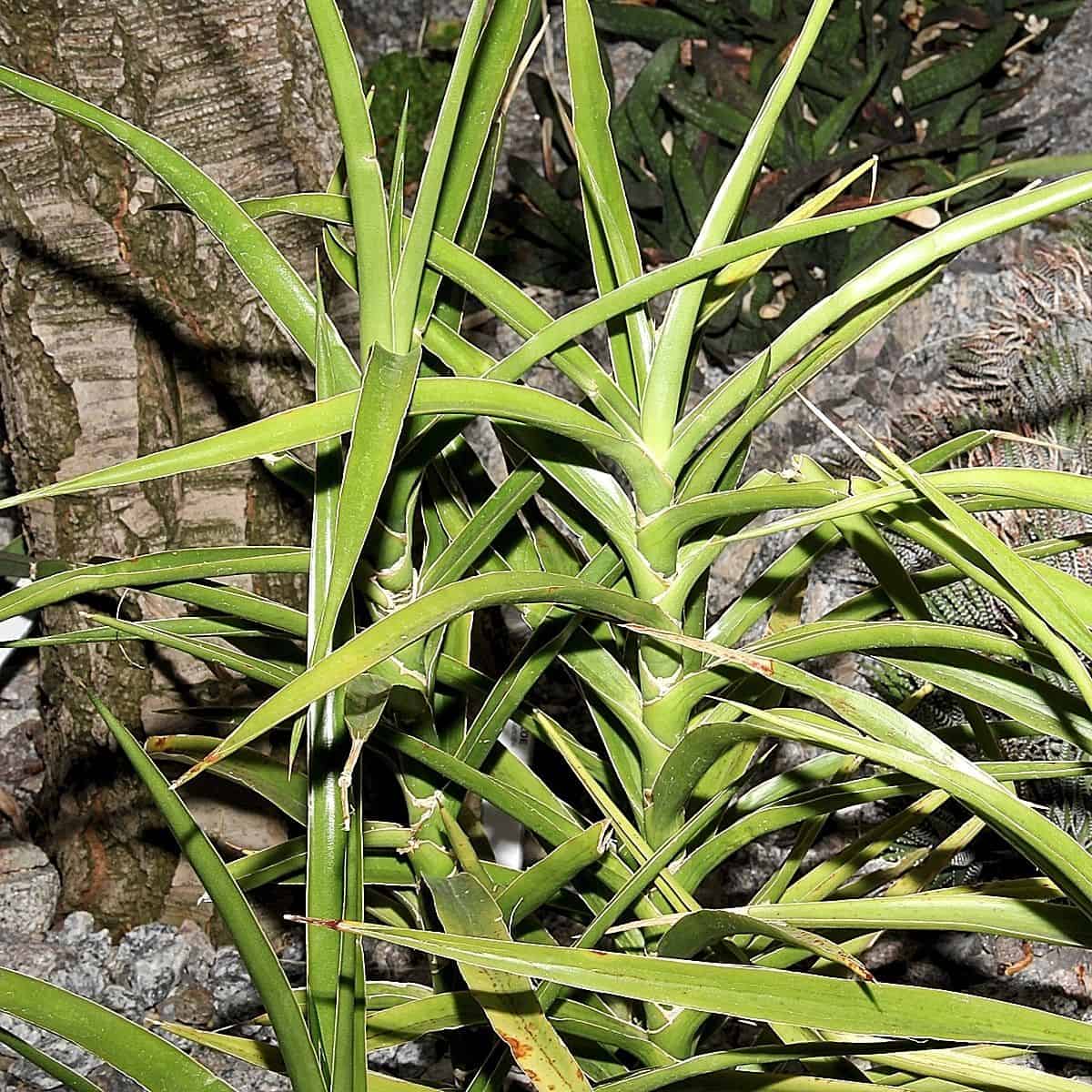
This is a rather interesting snake plant. Unlike plants that die after they flower, the snake plant will continue to produce new leaves and new flowers throughout its life. It will also begin to produce offspring at the base of the plant. The leaves are also incredibly interesting because they look like slightly serrated knives. These are native to both Kenya and Tanzania and make for a great indoor house plant
2. Sansevieria trifazciata - Bantel’s Sensation
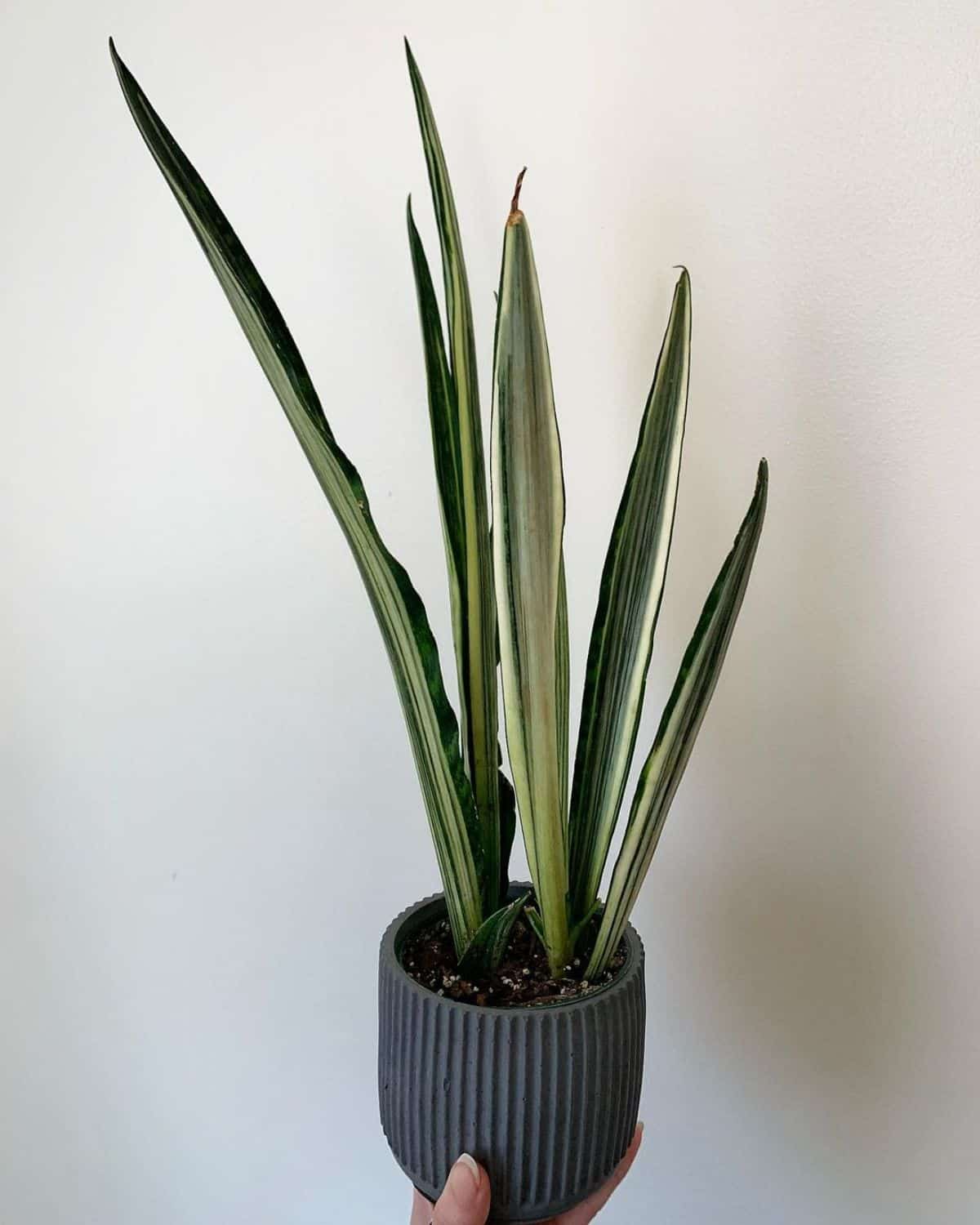
Buy it from:
When I first think snake plant, I do think of the pattern that is on Bantel’s Sensation. The vertical striping of light lime green, white, and dark green make for an interesting contrast in color throughout the plant. They can get up to 36 inches tall, and they actually have sweet-smelling flowers as compared to the carion-smelling flowers of other species.
3. Sansevieria Black Dragon
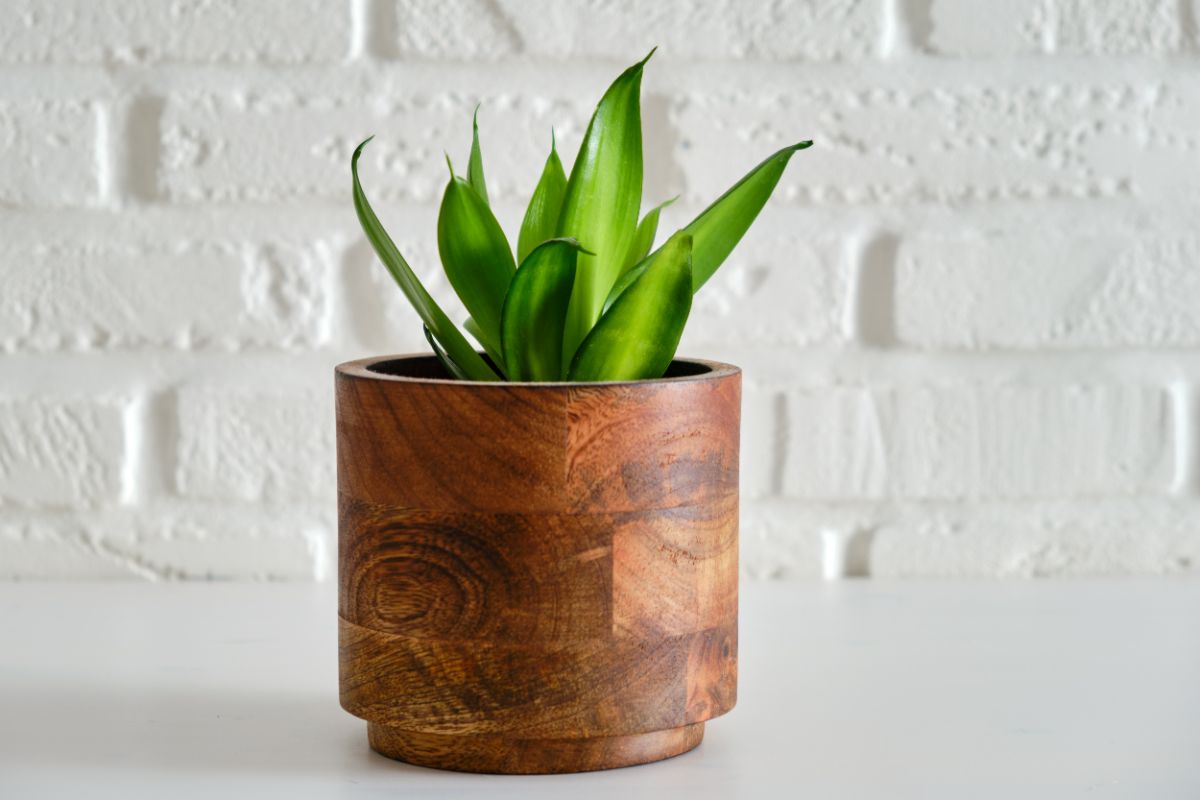
Buy it from:
Like many others of these species, the plant has very thick leaves that form more of a rosette shape as compared to other sansevierias. One of the benefits of this specific species is that it can withstand low-light spaces more so than others in this genus. This makes it a great indoor plant, like most snake plants.
4. Sansevieria Boncel Mini
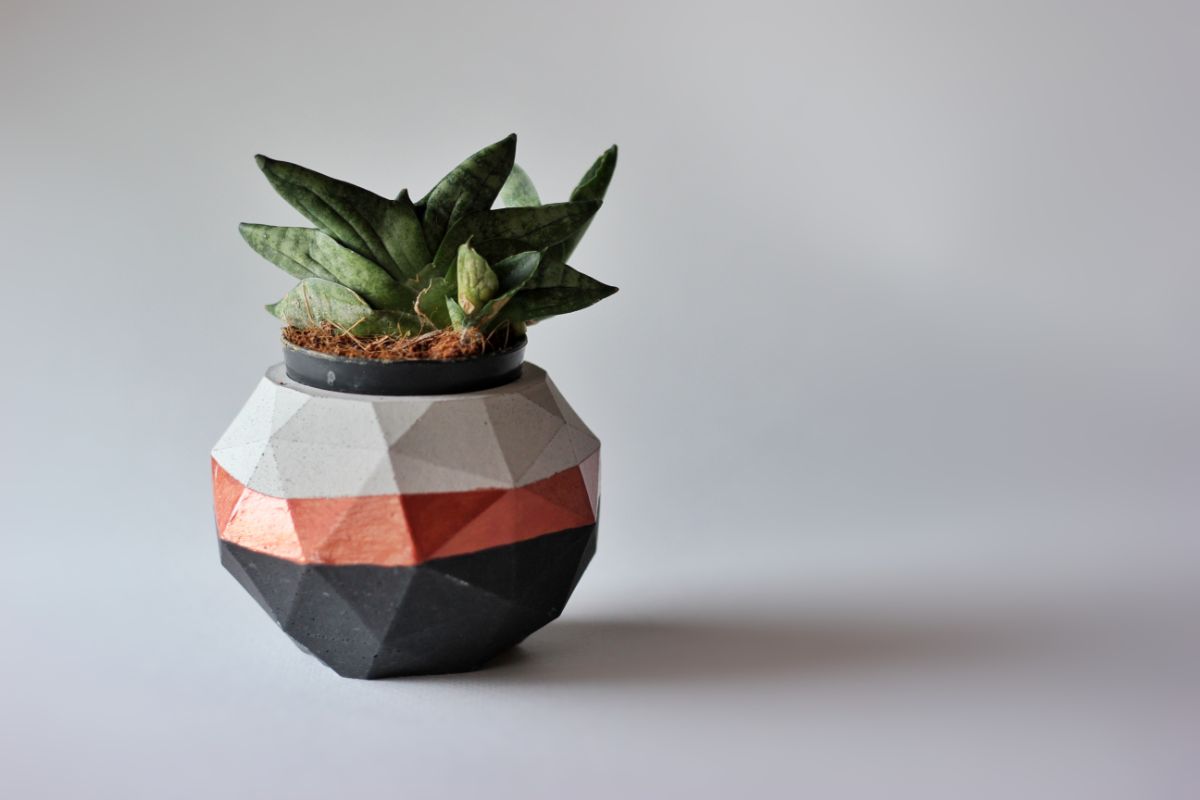
Buy it from:
This pretty mini is the smaller version of the next plant on the list. What makes it so special is that its leaves are used to harvest a very thick hemp rope. This rope is used to make bowstrings: in fact, it's called bowstring hemp! The downside of this species is how long it can take for it to grow. Depending on when you need that hemp, it may be a little bit of a wait. This is a rare type of snake plant; however, it is exceptionally adorable. What else gives them their unique draw is that their leaves are adorably thick, and the plant can, very rarely, crest-like other succulents!
5. Sansevieria Boncel variegated
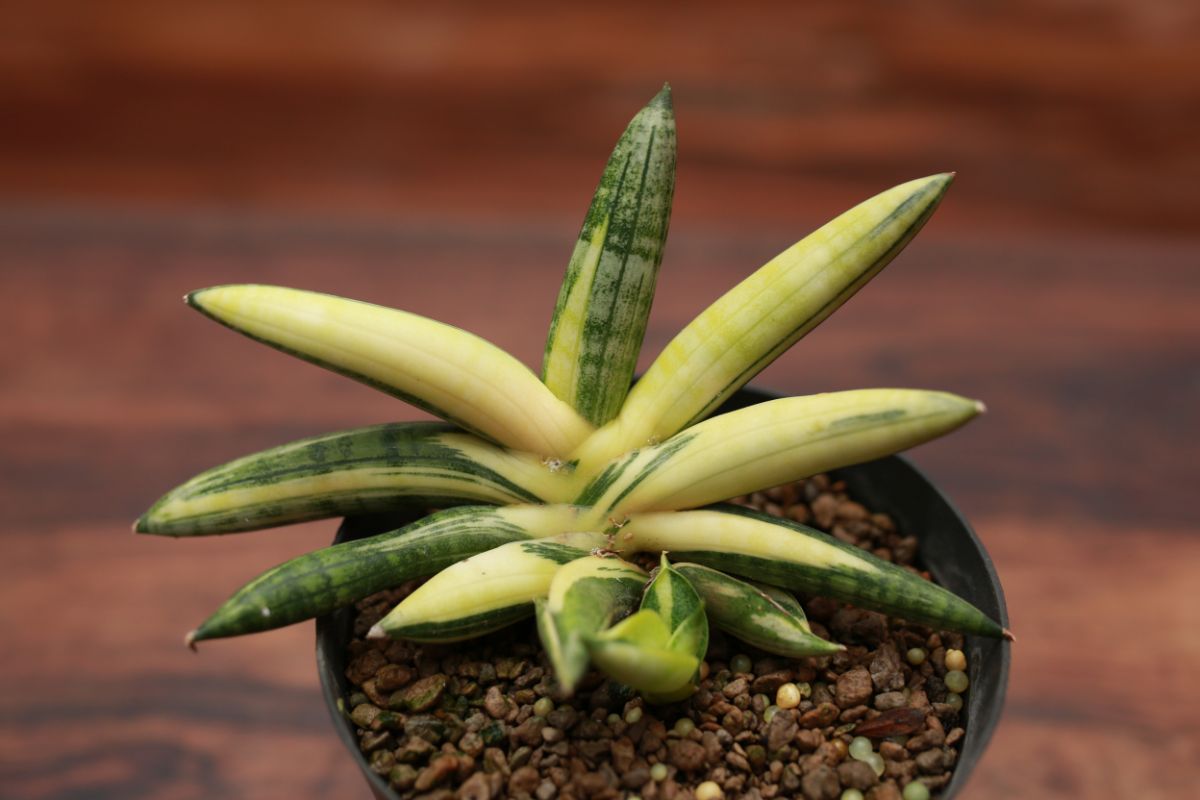
Buy it from:
The variegated boncel is very similar to the mini; however, the difference, of course, is in their size. Akin to the Aboke in the beginning, this plant has vertical variegation, which gives it a very unique look. This species can get rather large at over 12 inches tall, but they do start off as a cute pair of little lobster pincher leaves.
6. Sansevieria canaliculate
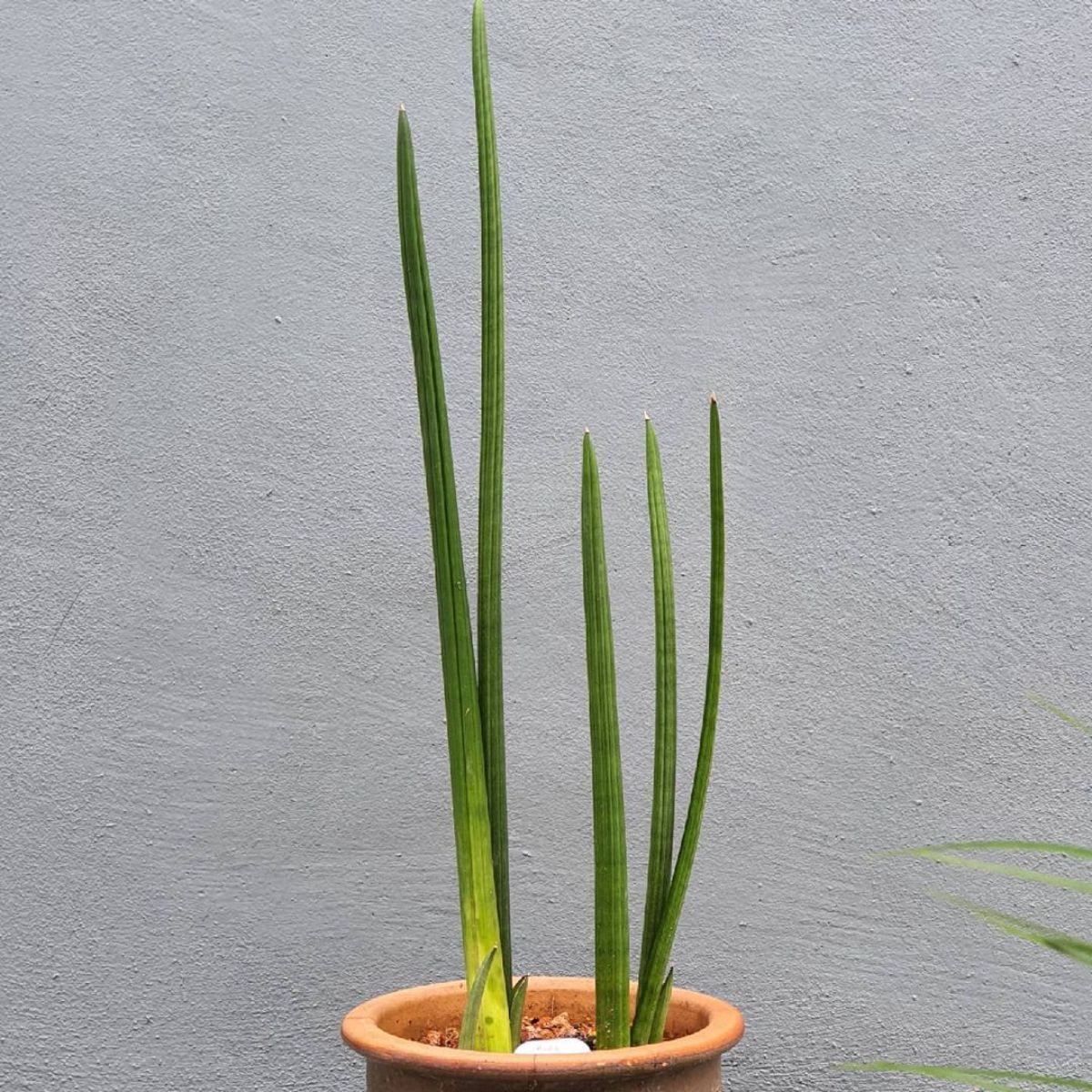
The cylindrical leaves of Sanseveria canaliculate measure up to three feet long and about an inch in diameter at maturity. The leaves grow either singularly or two at a time.
This Snake Plant is native to Madagascar and blooms in the spring. The flowers are tubular and greenish-white in color.
Sansevieria canaliculate prefers bright filtered light and well-draining soil. Infrequent water will keep this plant in top shape.
It is not a frost-tolerant plant and must be protected during temperatures below 50 degrees Fahrenheit.
7. Sansevieria Cleopatra
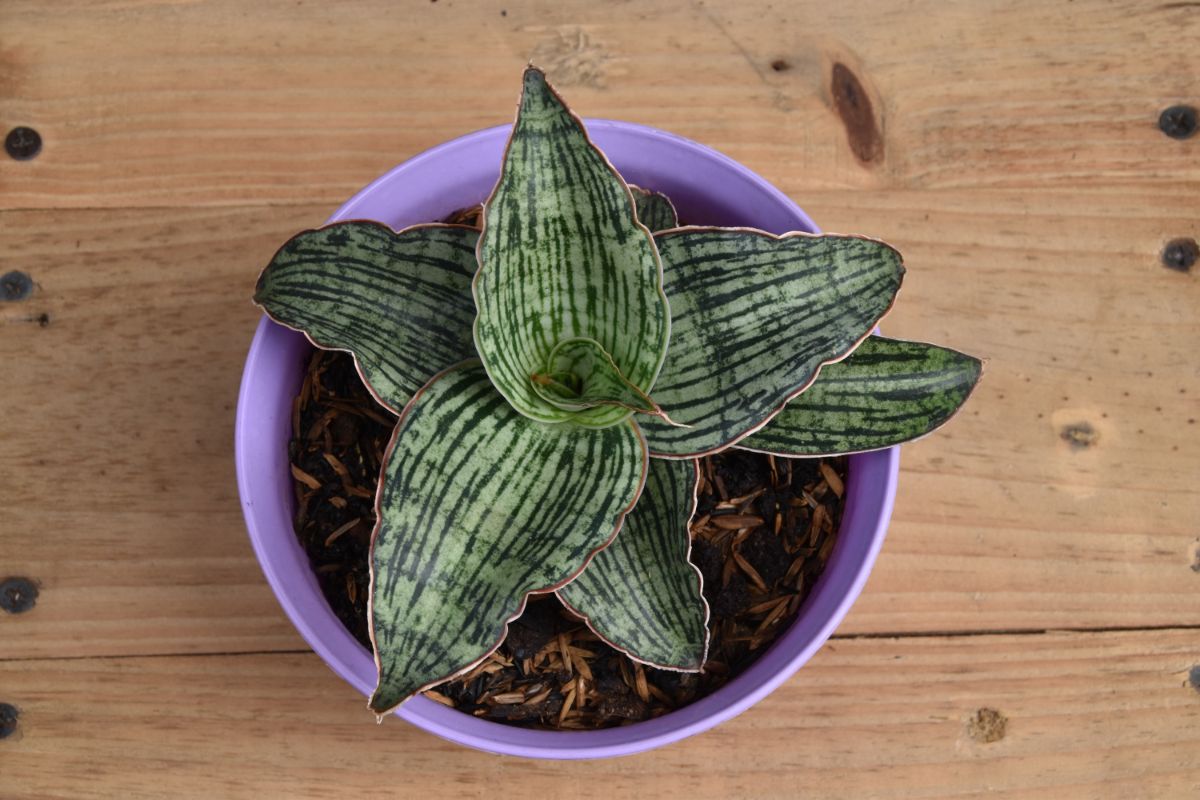
Buy it from:
If a plant could be charming, then this Cleopatra snake plant would definitely take the cake. With gently curling leaves and dark maroon pinstriping along the edges of the leaves, this plant has absolutely every character you could possibly want in a snake plant. The leaves are still thick and hardy, and their care still remains the same as with other snake plants.
8. Sansevieria cylindrica
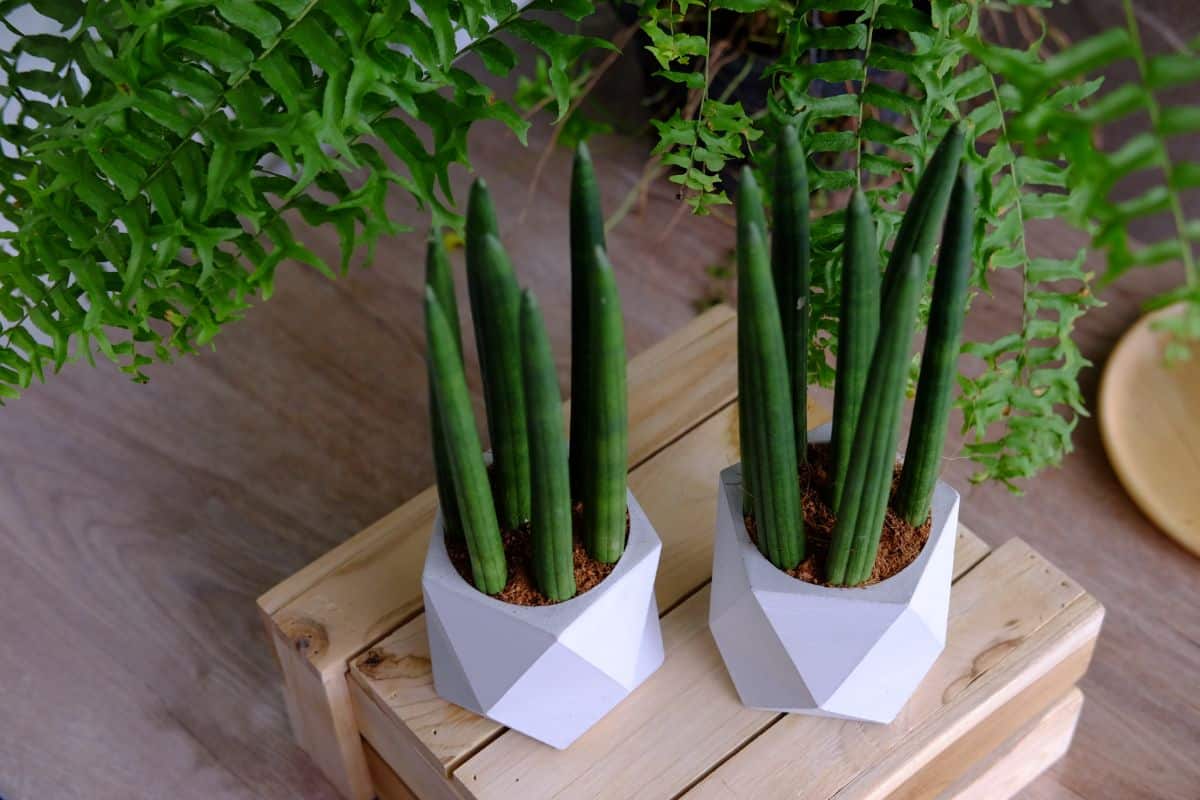
Buy it from:
This cylindrical variety of Snake Plant is native to Angola and is sometimes called ‘African Spear’. Larger than many other Sansevieria, the smooth rounded leaves can reach up to six feet tall.
It’s common practice to braid the leaves while they are young, securing them at the top. This helps control growth and creates a pleasing arrangement.
Sansevieria cylindrica is a great plant to use for landscaping, provided that you live in a warm climate.
Like other succulents, well-draining soil is essential, and water should be provided infrequently. This plant is mildly toxic, so use caution if planting in a location frequented by children or animals.
9. Sansevieria Ernestii
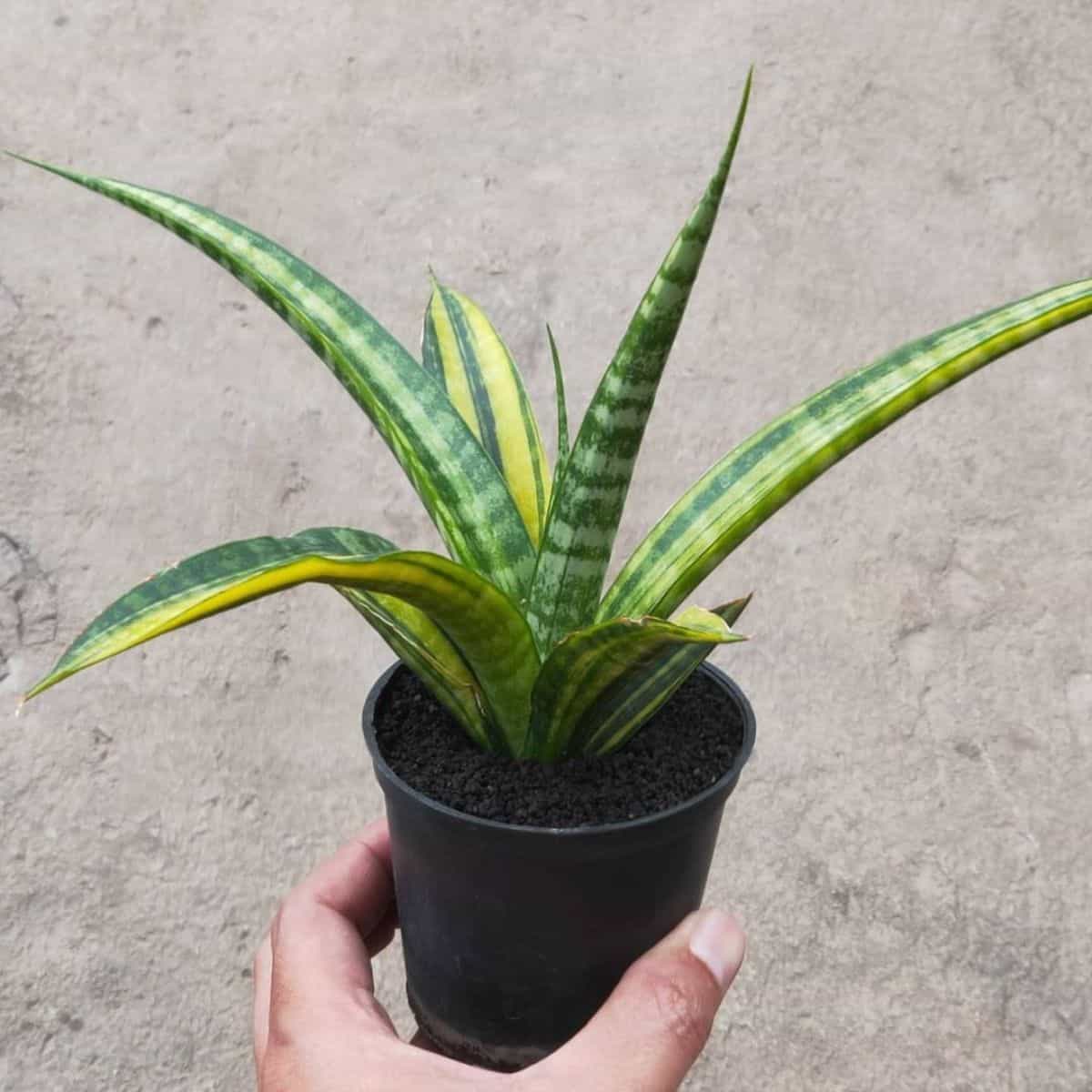
With this species, we begin to see a little bit of the characteristic bend of snake plant leaves. Instead of the cylindrical shapes that have been prevalent or the extremely flat, this species, like many other snake plants, tend to have very thick leaves that are more concave. They produce stunning white blooms on blooming stocks, and they also grow as bunches. There's no true rosette shape to the way the leaves grow; however, they do seem to alter their patterns.
10. Sansevieria Fernwood
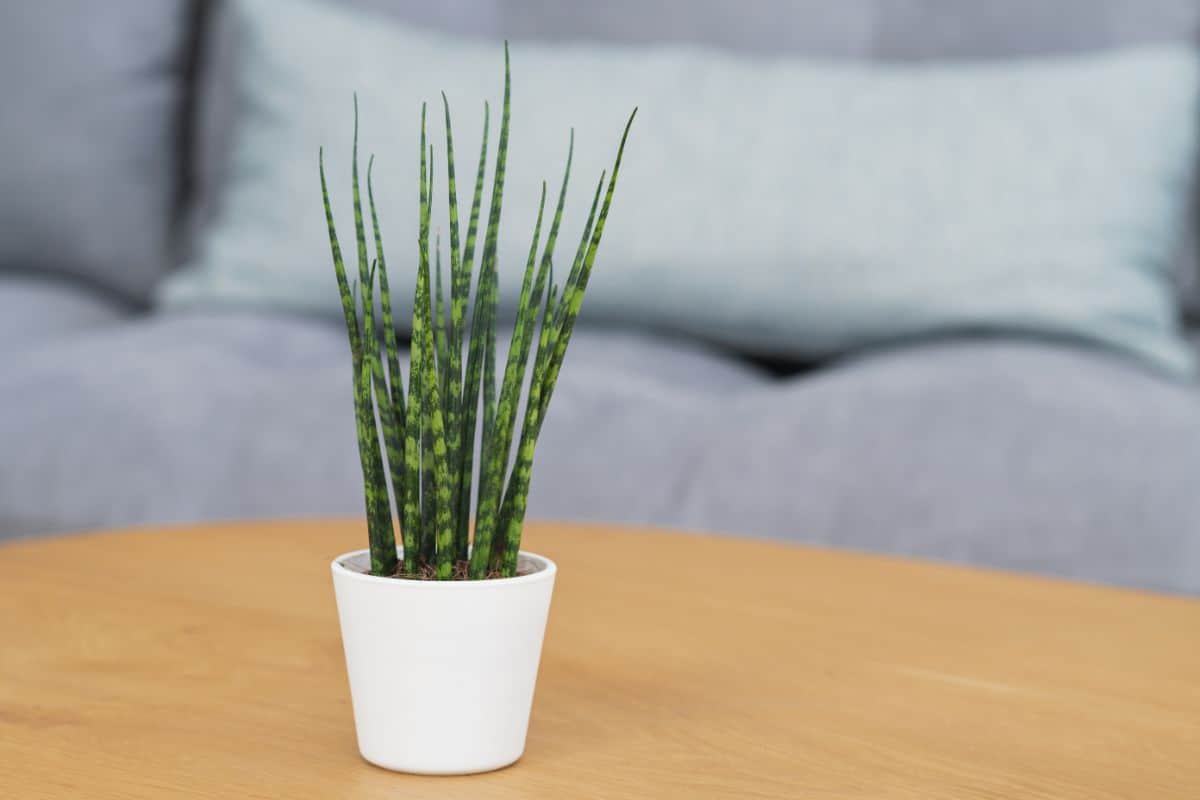
Buy it from:
Fernwood tends to be a favorite simply because it's one of those highly aesthetic plants. Instead of thin variegations along the leaves, there are vertical variegations that look more like splotches along the very cylindrical leaves. These also grow in a clump, and there is a specific parent body of the plant. The leaves will grow from that body and will continue to fill up whatever space they are in.
11. Sansevieria fischeri
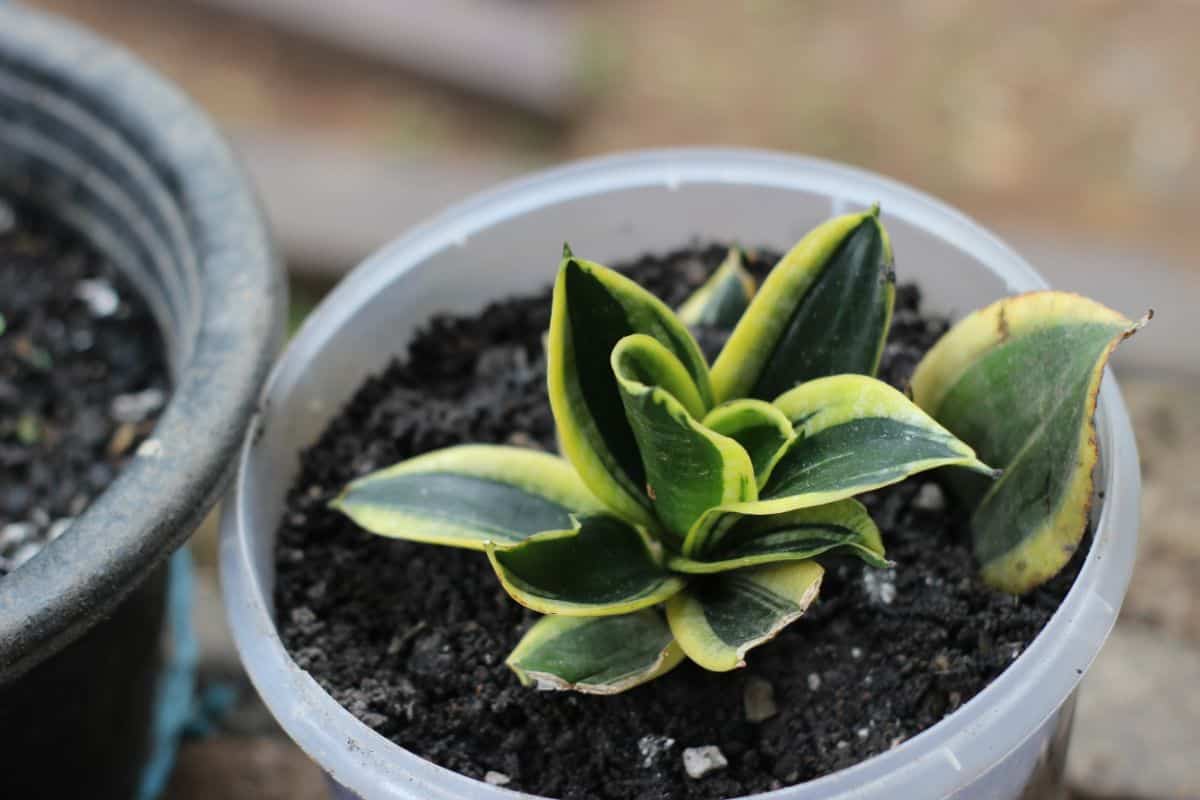
Buy it from:
Sansevieria fischeri is one of the smaller varieties of Snake Plant, measuring less than 16 inches in height at maturity.
It’s an ideal plant for container gardening but can also be grown successfully outdoors. In the summer, the plant produces an inflorescence with a cluster of tubular white flowers.
This variety of Snake Plant does well with plenty of suns and adequate drainage. It’s not a frost-tolerant plant, so be prepared to bring the plant inside or protect it if the temperature dips below freezing.
12. Sansevieria futura robusta
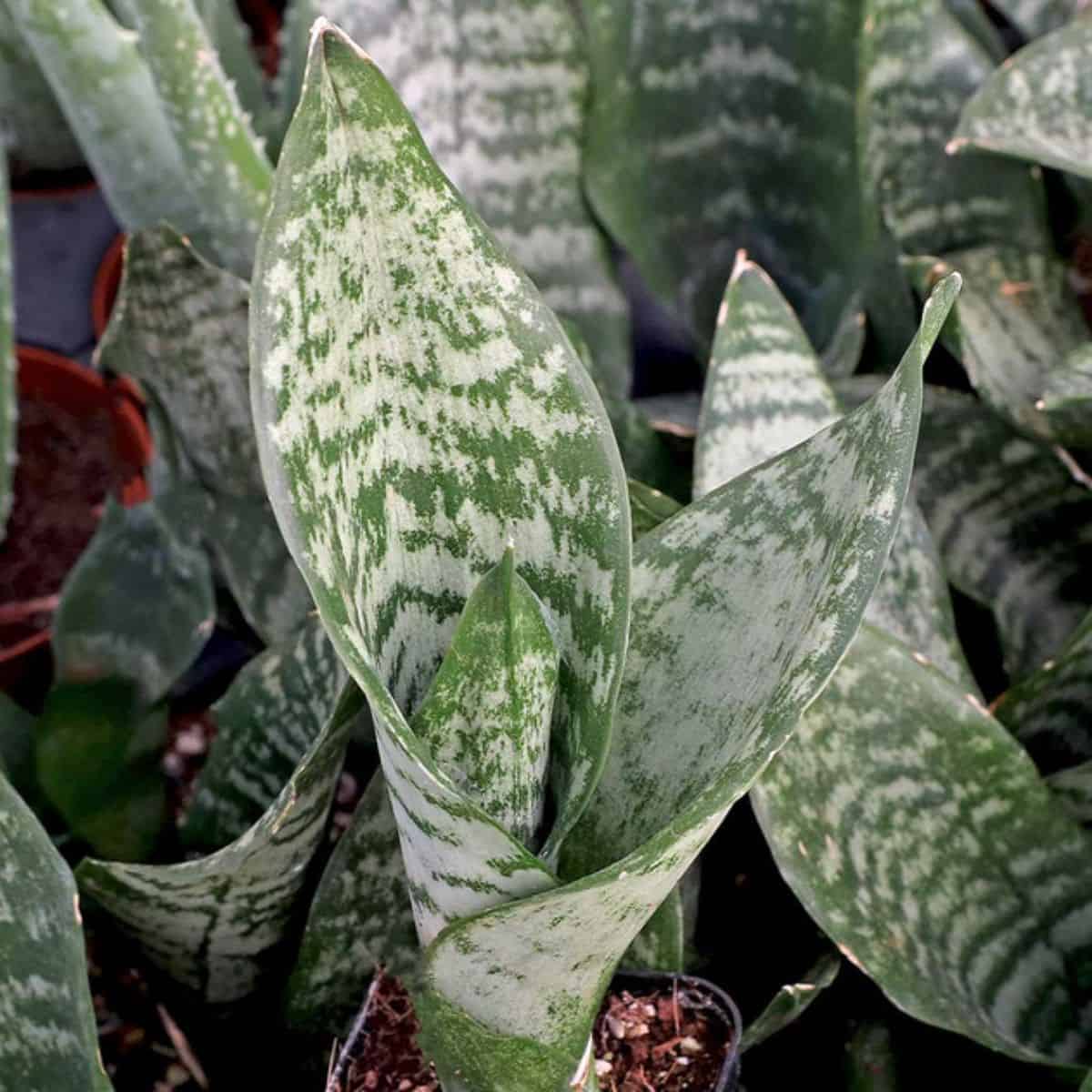
Buy it from:
Yet another beautifully broad-leafed species for this genus! The variegation is vertical on this plant. There are larger lines of white or light green compared to the stripes of dark green. This gives it a much lighter look that can brighten up any space. As always, with these types of plants, they are great to be grown indoors. The leaves are very broad on this plant, but they are still slightly thick, which shows their succulent tendencies. Like most of these species, they don't bloom very often when indoors; however, they can still brighten up a room with their beautiful patterns. One other thing to remember about this species is that you can stress them in order to force them to produce a bloom. However, I do not suggest this for the new gardener
13. Sansevieria gold flame
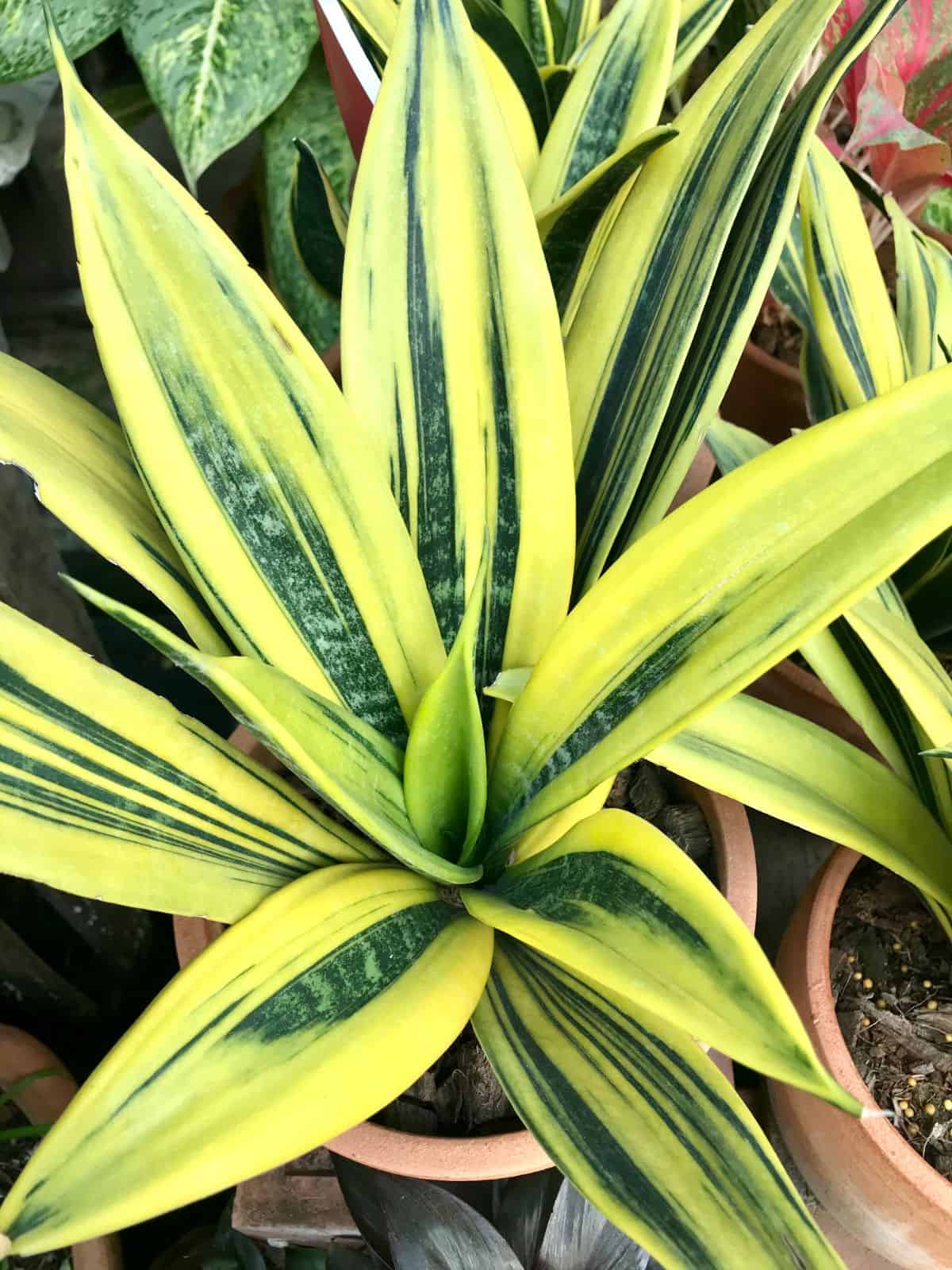
Buy it from:
Instead of seeing the typical green towards the outside and yellow towards the inside, with the gold flame sansevieria we instead see a pattern that is yellow green yellow. The yellow is extremely intense and very bright on most of the leaves. Keep in mind though, that the leaves are still going to be those thick succulent leaves, and they're going to be a little more narrow than the past few species we've been covering.
14. Sansevieria golden wendy
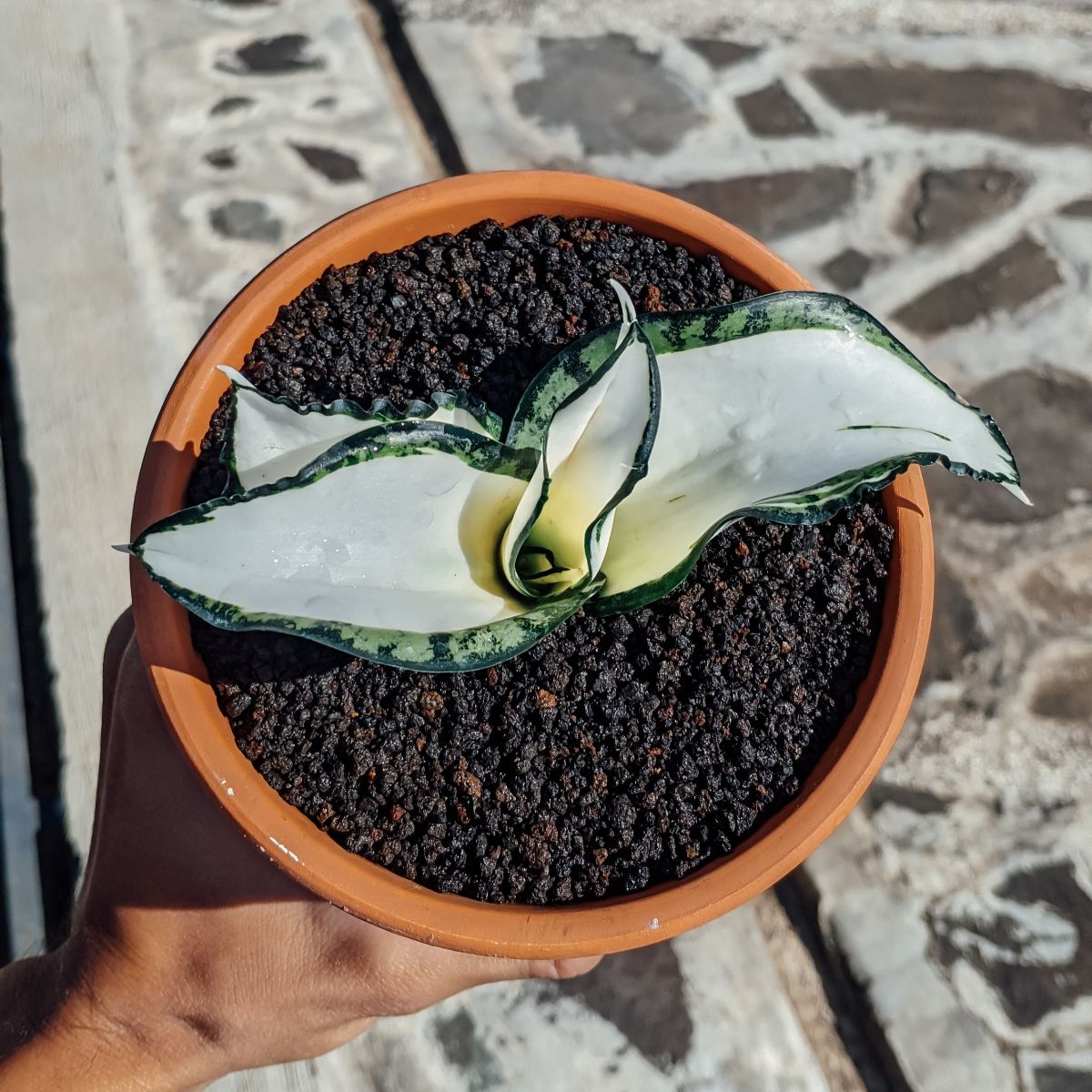
Buy it from:
Yet another gold variety, the gold Wendy, tends to be the one that takes the show. Gold Wendy is outlined in a green pinstriping that highlights the bright buttery yellow center of the leaves. The leaves also tend to swirl in a clockwise or counterclockwise direction. On top of that, if you're lucky, sometimes you can even get varieties that have a little bit of a wave in their leaves as well. Much like any other snake plants, keep them watered the way they need, and let them grow. Keep in mind, too, that the golden Wendy is a broad-leafed sand plant and will eventually need larger space
15. Sansevieria gracilis
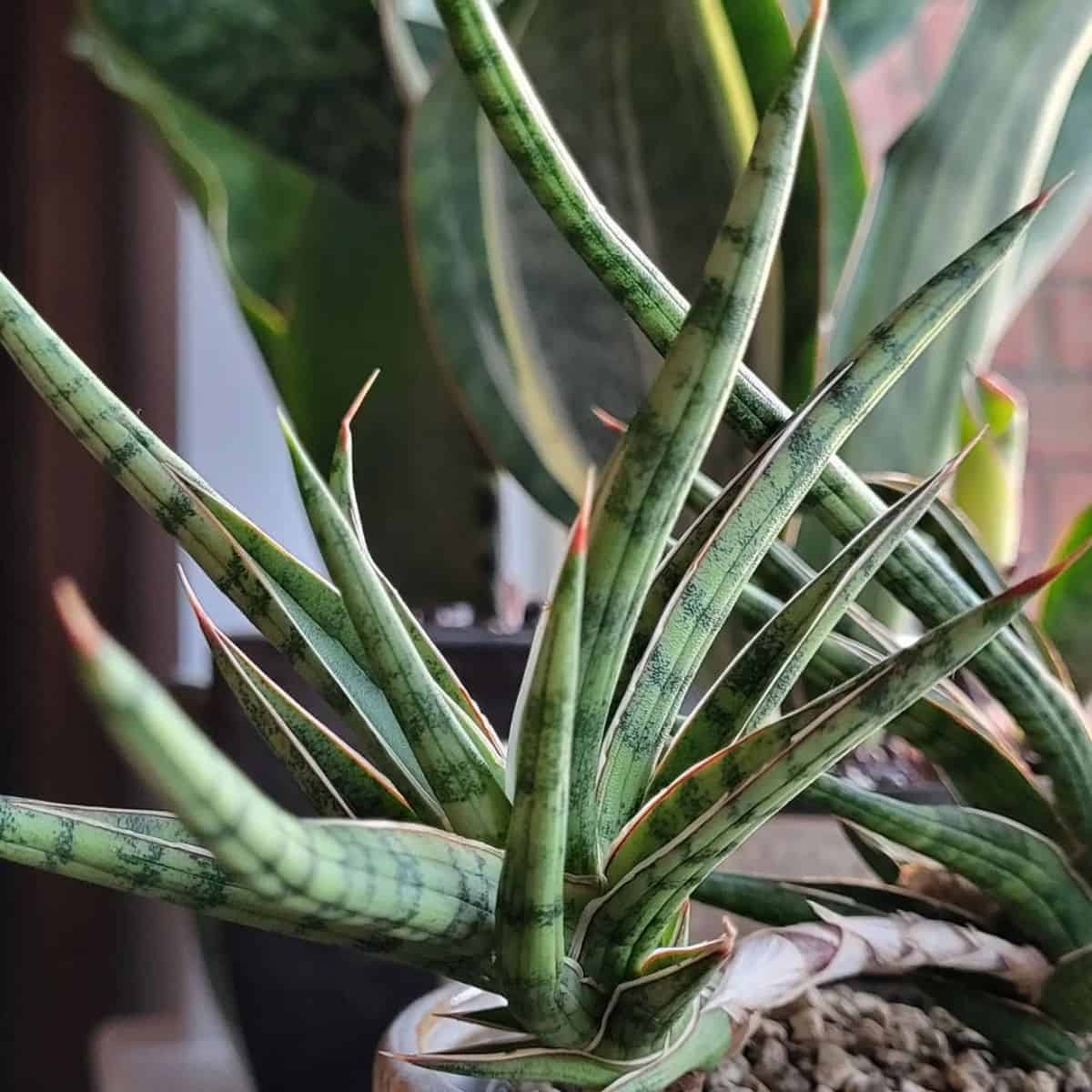
This Snake Plant is one of the more petite varieties. Typically, the leaves stay under about 18 inches in height.
The green and white banded are long and pointed, as with most varieties of Sansevieria. It typically blooms in late fall and produces clusters of greenish-white flowers.
Bright filtered light or partial sun is ideal for Sansevieria gracilis. It’s possible for this plant to grow in full shade or low-light conditions, but the colors will not be as vibrant as they would with more sunlight.
As with most varieties of Sansevieria, propagation is possible through leaf cuttings and offsets.
16. Sansevieria grandis
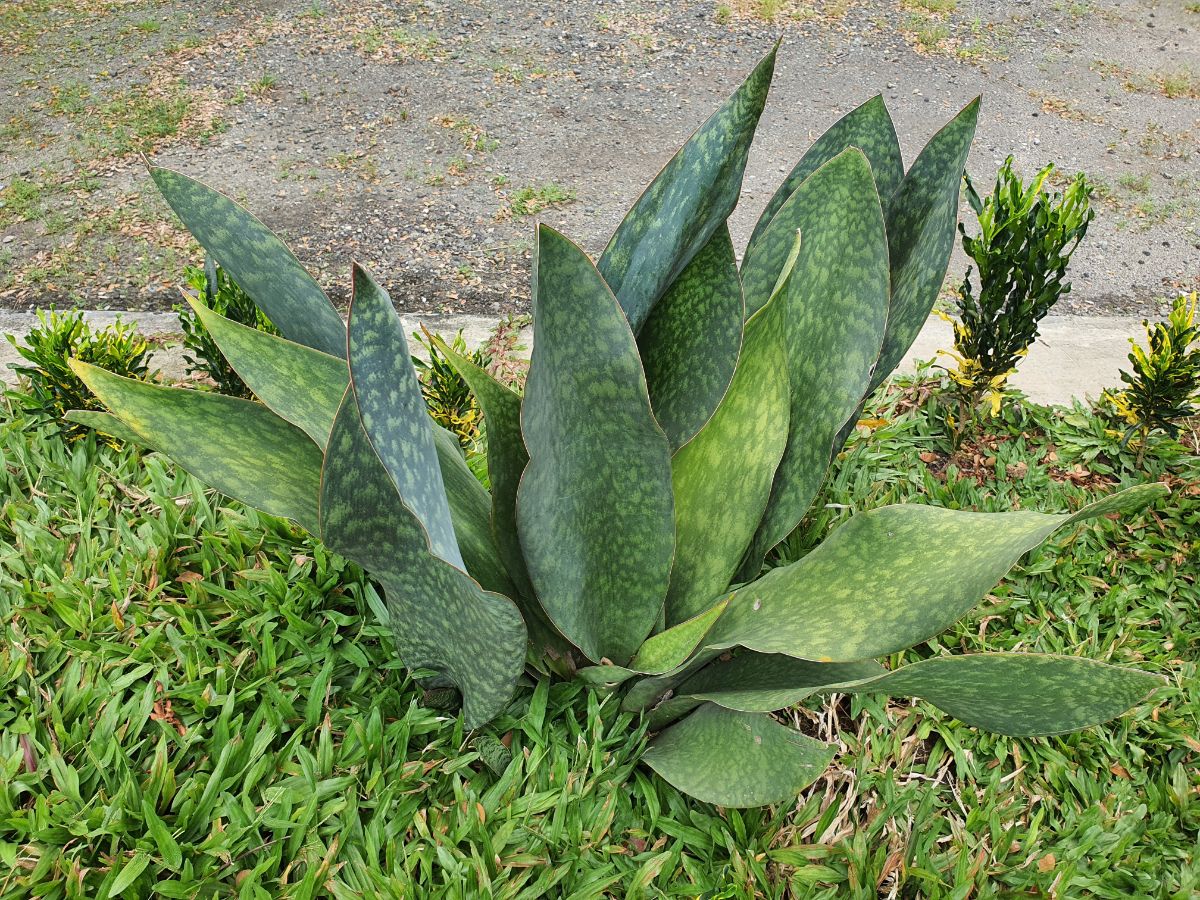
The grandis is an impressive plant. Usually, when it starts off, it's with two absolutely massive leaves that are opposite one another. As it continues to grow, the plant begins to take on a slight Rosette-ish shape; however, the leaves stay straight up. Many propagated plants can come from one snake plant leaf, so be prepared to also use offshoots to make or to pot new sand plant grandis. The species can appear very agitated due to the light green or almost yellow modeling that occurs throughout the leaf. It does seem to give it the appearance as though it is textured as well
17. Sansevieria green hahnii
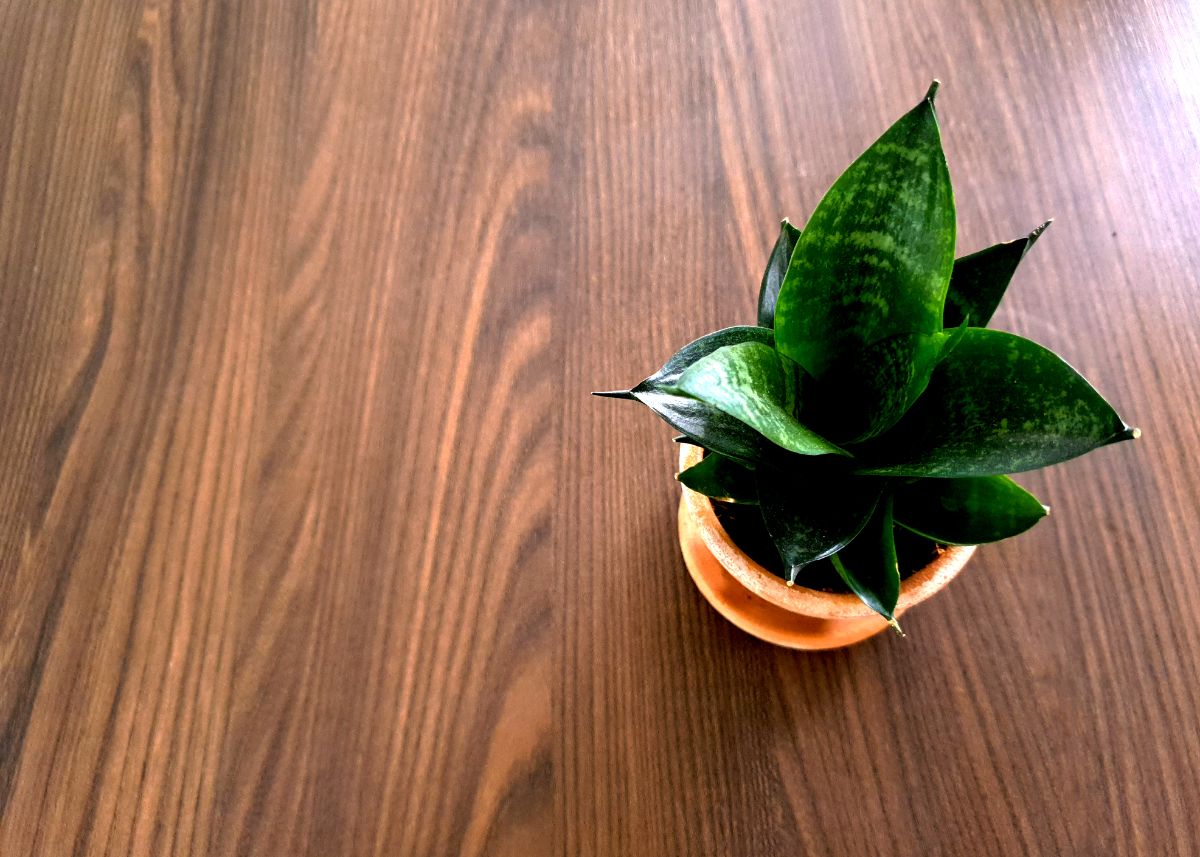
Buy it from:
Hahnii types of sansevierias are smaller, and they can easily grow in and outdoors. Like most of these plants, they do have to have some shade. This species is also known as the bird's nest snake plant. It does have a very heavy texture on it that makes it look as though if you ran your finger across it, you'd feel ridges. It does start to grow in a rosette-type shape, with a cone-like center in the middle, almost like a bromeliad.
18. Sansevieria guineensis variegate
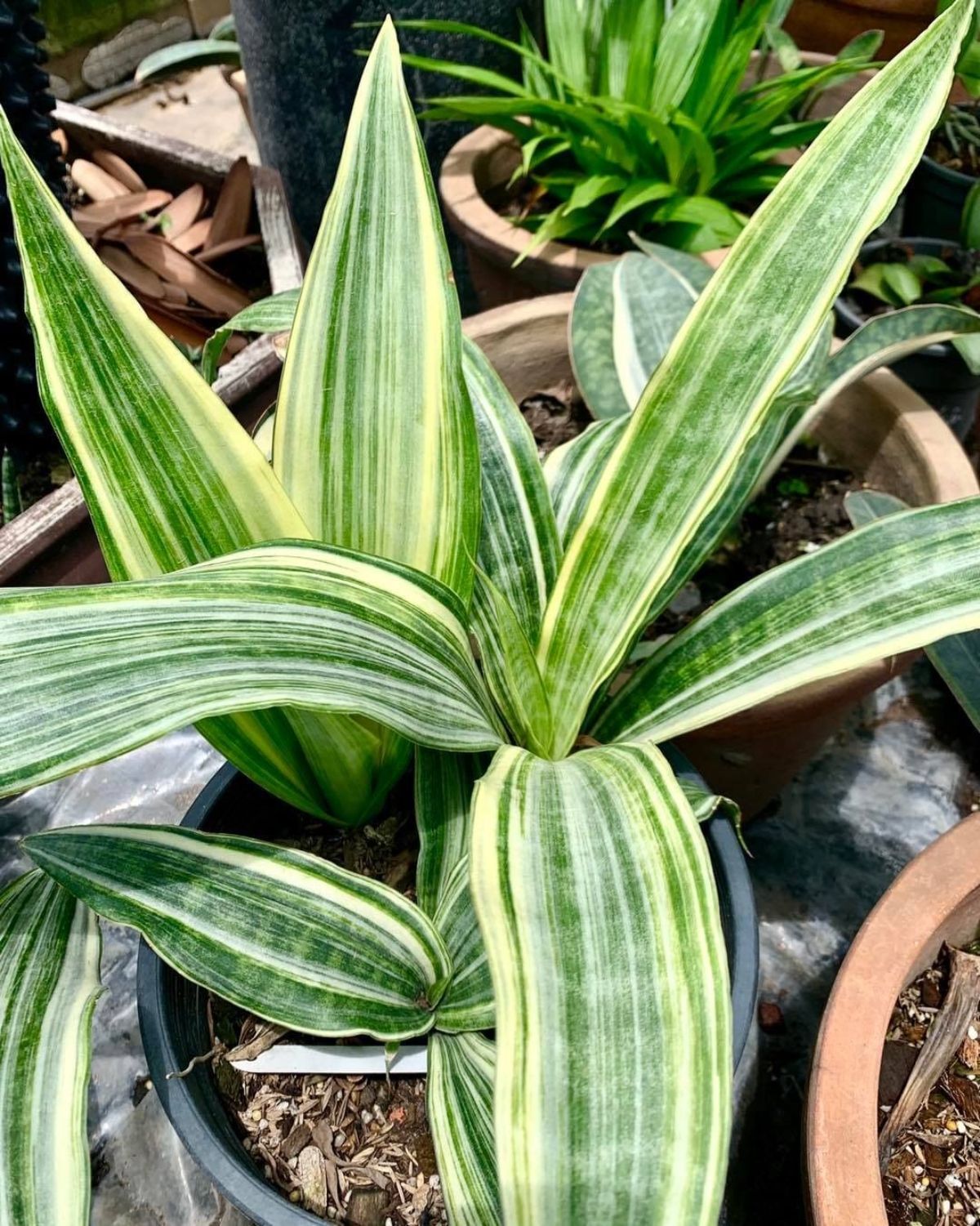
So far, we've seen two different variegated species that deal with a lot of the color yellow. The golden Wendy was a solid butter yellow center, and then the golden flame was more so a variegated pattern. The golden hemp snake plant has a different pattern where the yellow outlines the leaf and the green takes the center technically; this is considered variegated and also unique. The leaves are definitely waving, and they're also far narrower than other leaves that we've seen so far. That is other than the caniculata.
19. Sansevieria hahnii jade
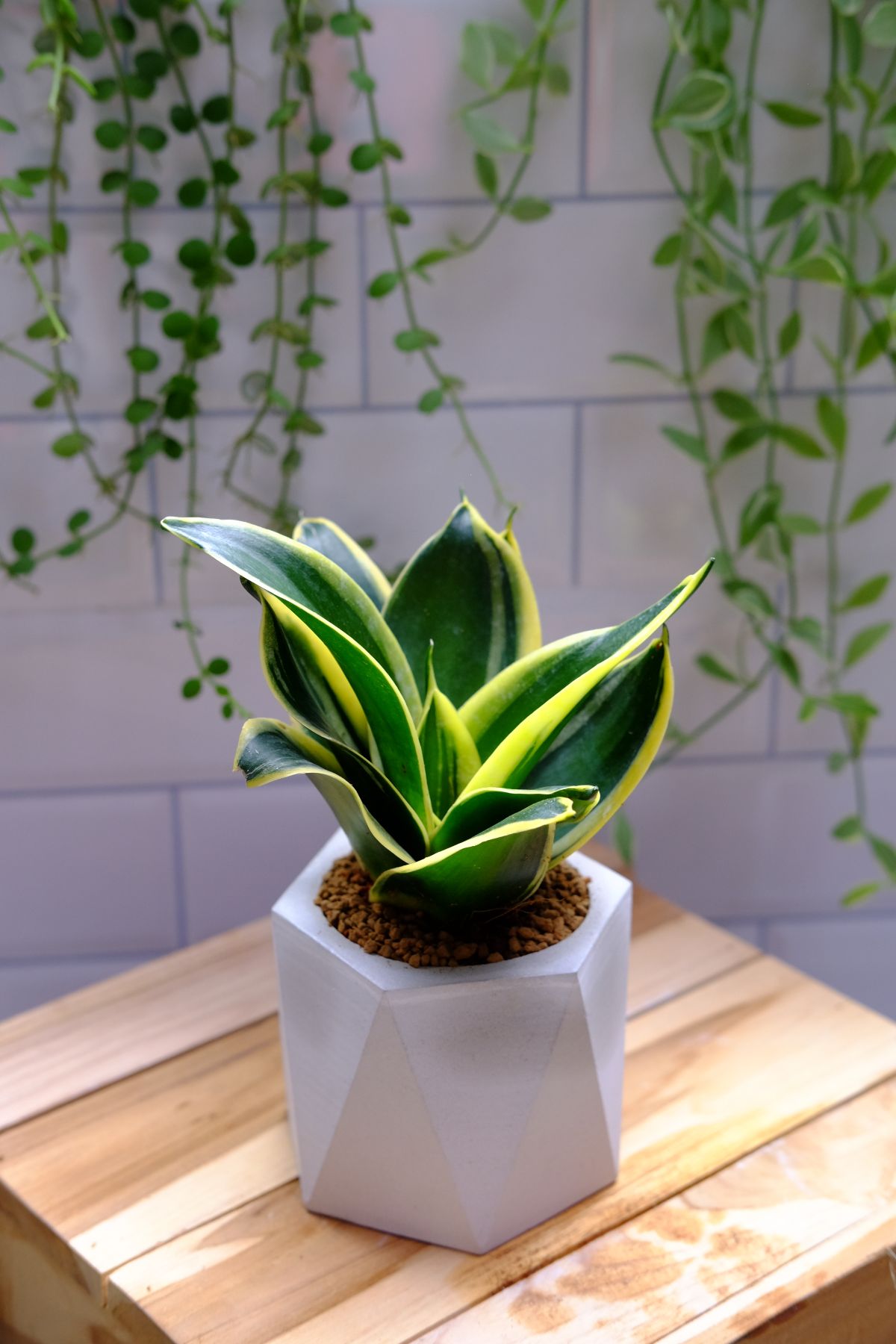
Buy it from:
There's also a very jaded version of the golden hahnii as well as the original hahnii that we covered two species ago. While the others are green, some are gold; this one is a deep jade. It is an extremely dark plant, but it can still be seen as green. It is a bird's nest type of snake plant, and it does grow fairly well both indoor and outdoor when given the appropriate environment.
20. Sansevieria kirkii coppertone
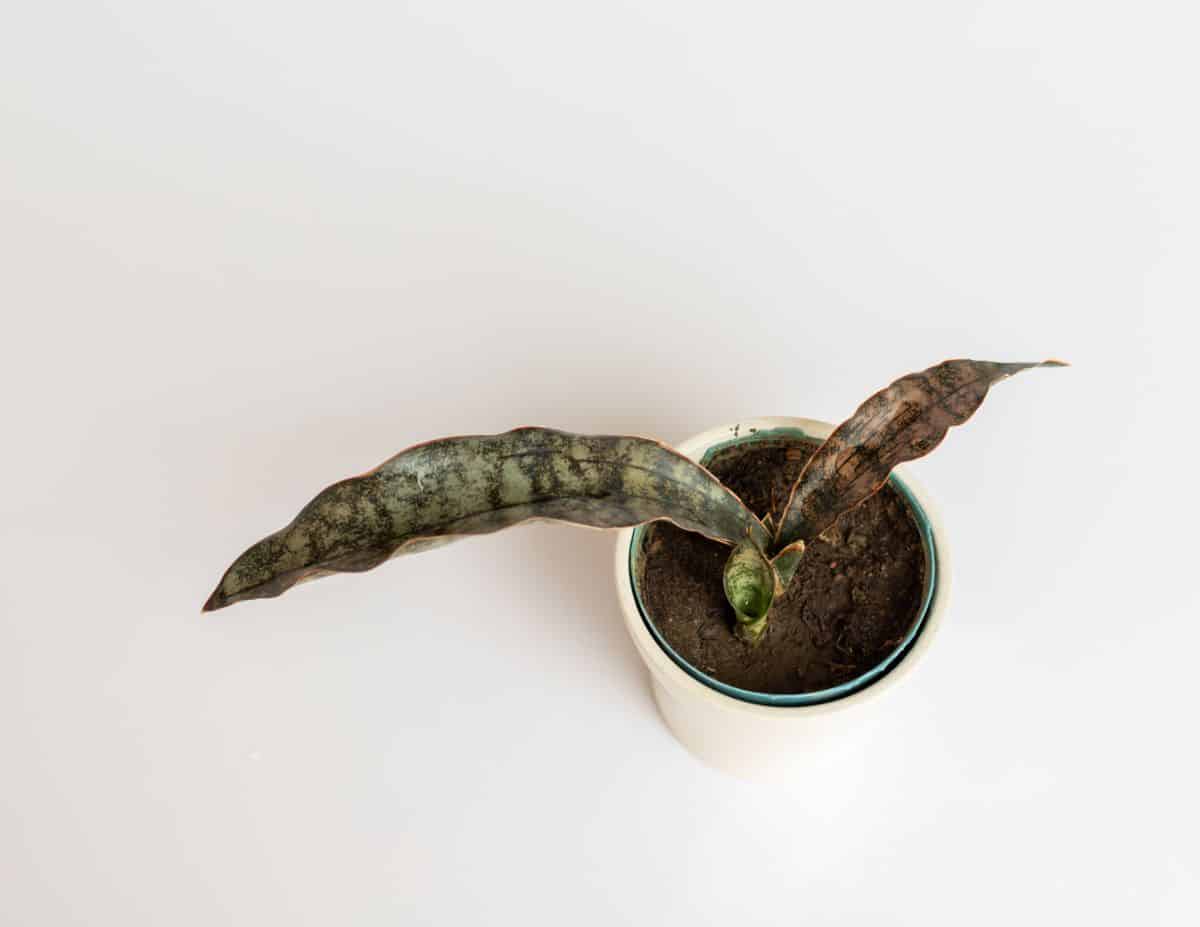
Buy it from:
Out of all of the species of snake plants that I've seen for this research, this one tends to be my favorite. Now I know I said that about the Cleopatra as well; however, this species is truly unique because instead of it being typical yellows, pinks, golds, and varying shades of Blues and greens, we instead have a pinkish brown type of sansevieria. This pinkish brown color is extremely attractive and adds a nice accent to any minimalist style, but you can also use it to help decorate in a more western way as well. The leaves are undulate, and they also have variegation of green and yellow that gives it its traditional copper tone color
21. Sansevieria Lady gaga
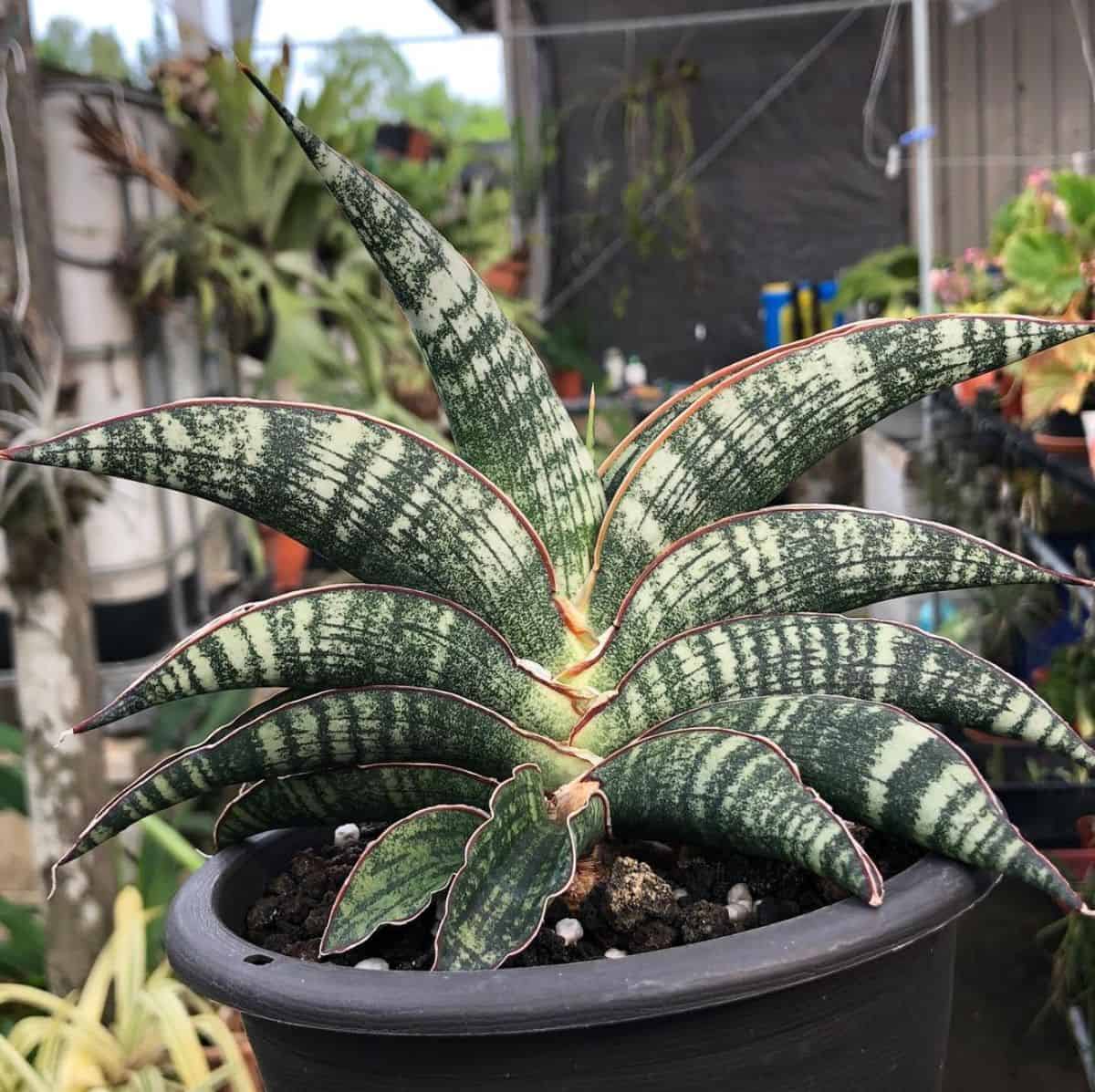
With plants that are already so incredibly wonderful and sometimes a little bit out there, it'd be hard not to have a hybrid named after the queen of uniqueness herself, Lady Gaga. What sets this snake plant apart is that its leaves are curved very tightly. But what is so surprising is they are curved tightly enough to where it looks as though they are the cylindrical versions of other snake plants. They are variegated, and they also have some undulation depending upon what crosses were made in obtaining your specimen
22. Sansevieria Macrophylla
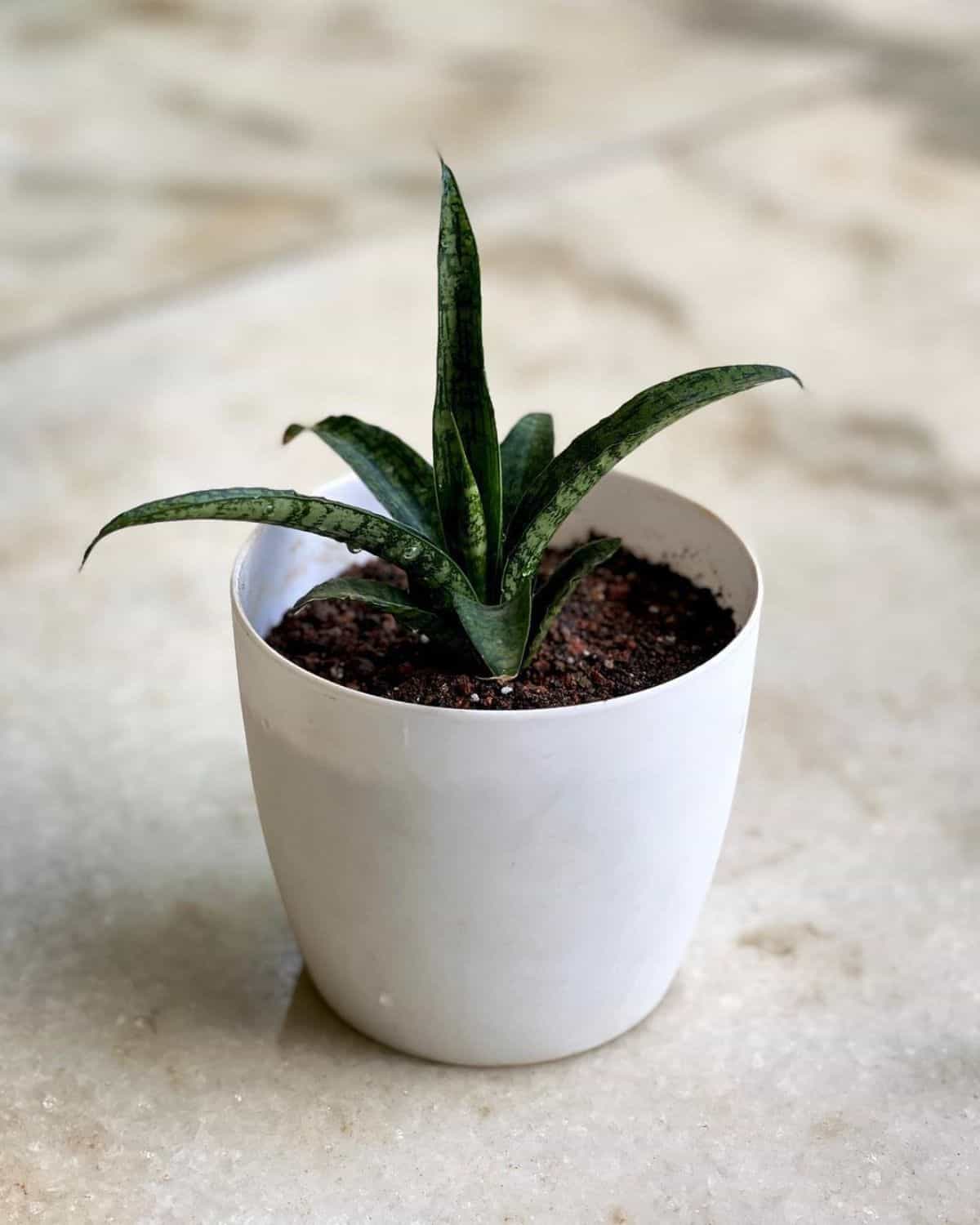
With thick rigid leaves, this species can withstand quite a bit before it decides to kick the bucket. The leaves of this plant are very straight and very firm in their direction, and they are also variegated too. Most of the time, it looks like water splotches that are on the leaves; however, this is the natural coloration of the plant. Keep in mind that all snake plants need the proper amount of lighting. Additionally, you may find some of this species with a variegated leaf that is more so on the striped edge of variegation. Whichever you find, you will definitely enjoy the slightly undulated and wavy addition to your snake plant collection
23. Sansevieria masoniana
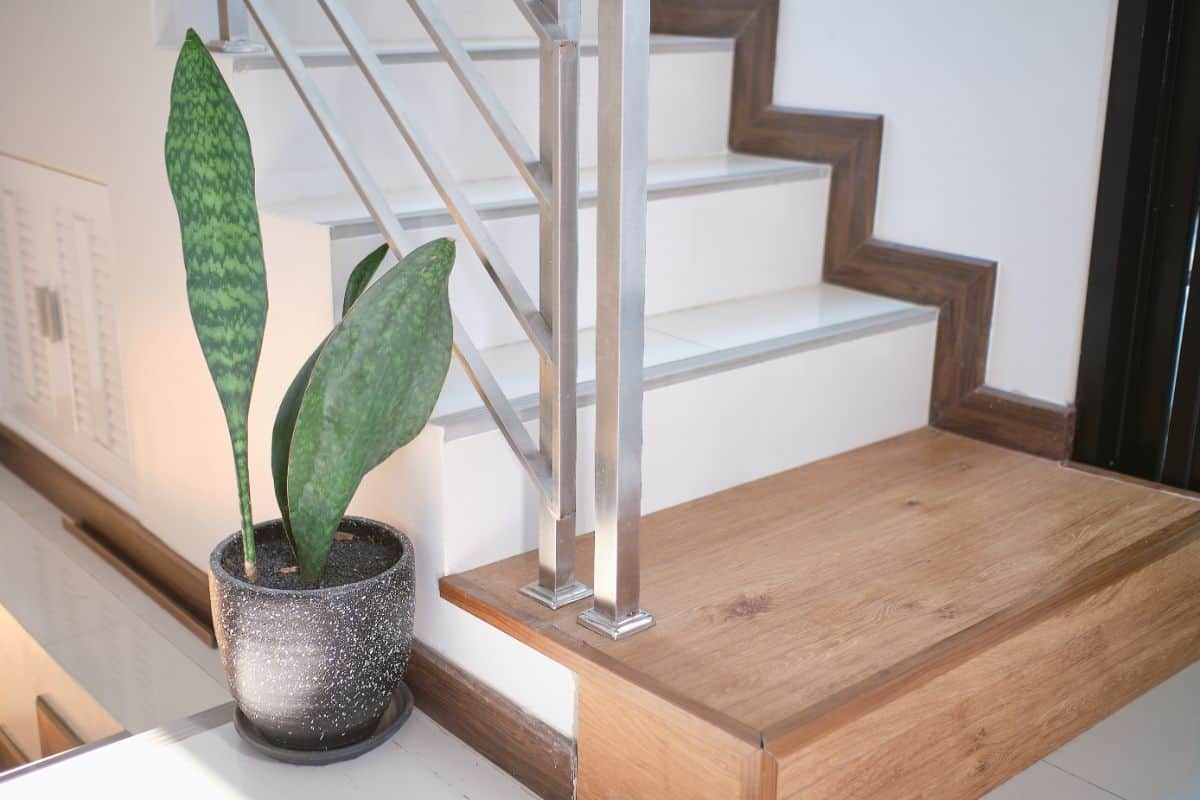
Buy it from:
Sometimes called Whale’s Fin or Shark’s Fin, this Snake Plant is native to central Africa. It has broad, mottled green leaves that can reach up to four feet in length.
The paddle-shaped leaves may also be variegated, depending on the cultivar. This plant can easily be identified by its purple-banded sheath, but this is often below the soil line.
Sansevieria masoniana thrives in bright light. In fact, this plant is unlikely to bloom if it does not receive enough sunlight.
It requires water only when the soil is dry and should never be left in standing water. This Snake Plant will not tolerate freezing temperatures, so it will need to be protected during particularly cold weather.
These are just a few of the many wonderful sansevieria varieties. Snake Plants are perfect for indoor container gardens and outdoor landscaping alike.
They’re easy to care for and are a great choice for both inexperienced and expert gardeners. With so many shapes and colors to choose from, how can you bring home just one?
24. Sansevieria Masoniana variegate
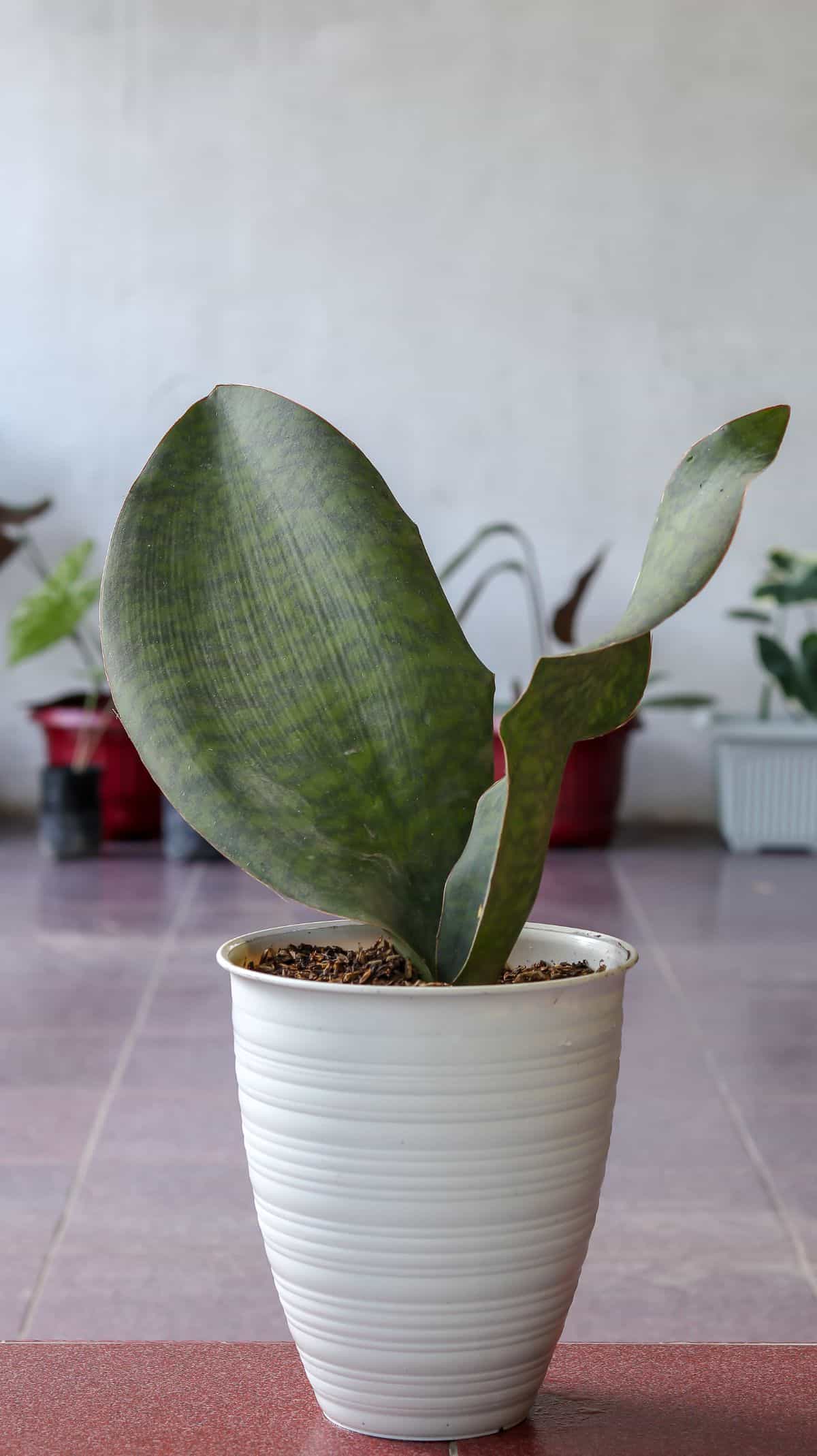
Buy it from:
Just like the plant before, this is also a whale fin type of snake plant. Rather than being all green or splotching, this particular species is variegated with a vertical stripe rather than a horizontal one. The vertical stripes are alternating, and you will find that some have larger strips of yellow or larger strips of green. More often than not. You will find them started off as one plant because, as are most snake plants, they are rhizomatic.
25. Sansevieria Marginata
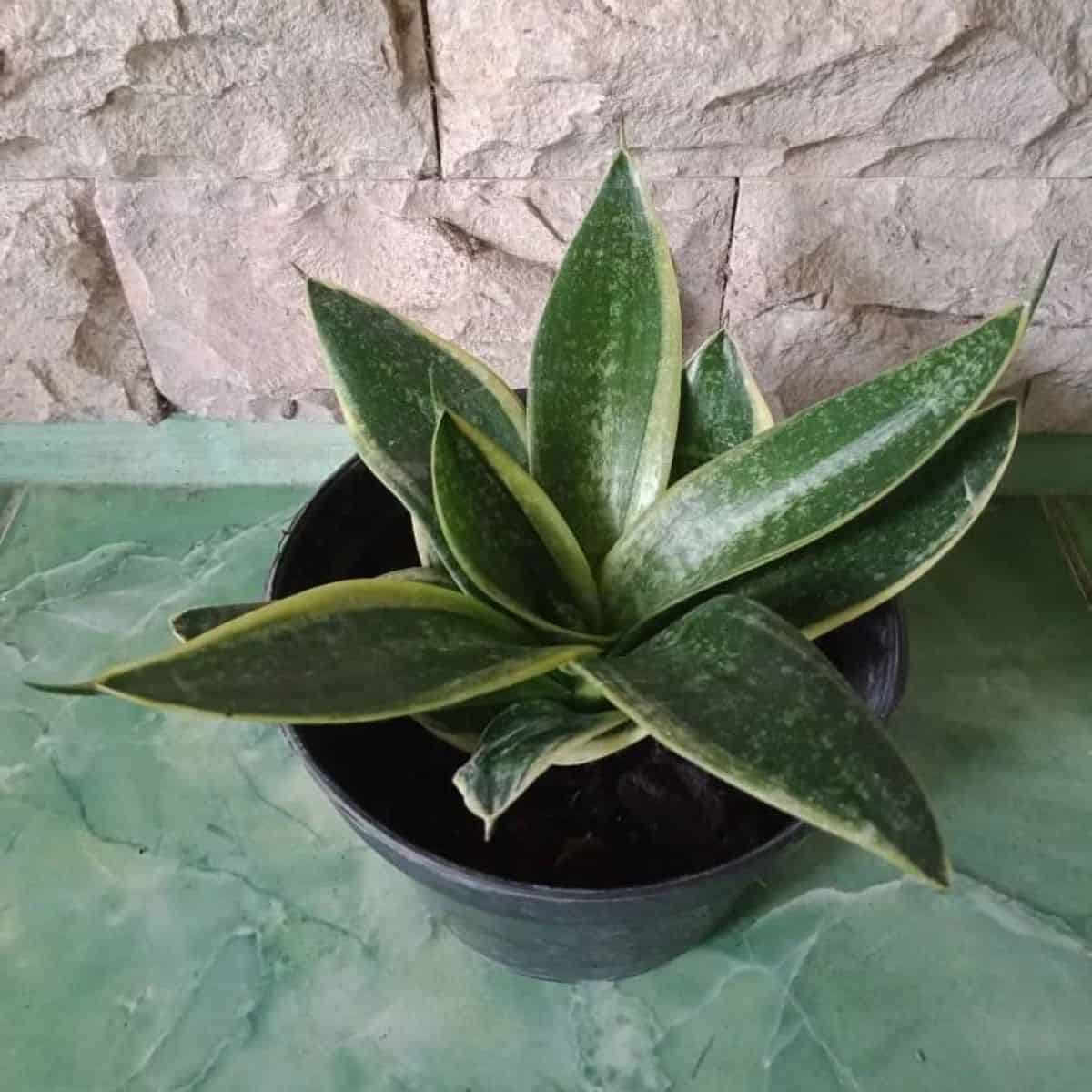
If you are looking for that quintessential snake plant appearance, then this one is for you. It has only the dark jade center and the semi-shiny pointed leaves with yellow variegation along the outside of the margins. They do come to a tip; however, they will also stay slightly small as they are part of the bird's nest snake plant group
26. Sansevieria Metallica
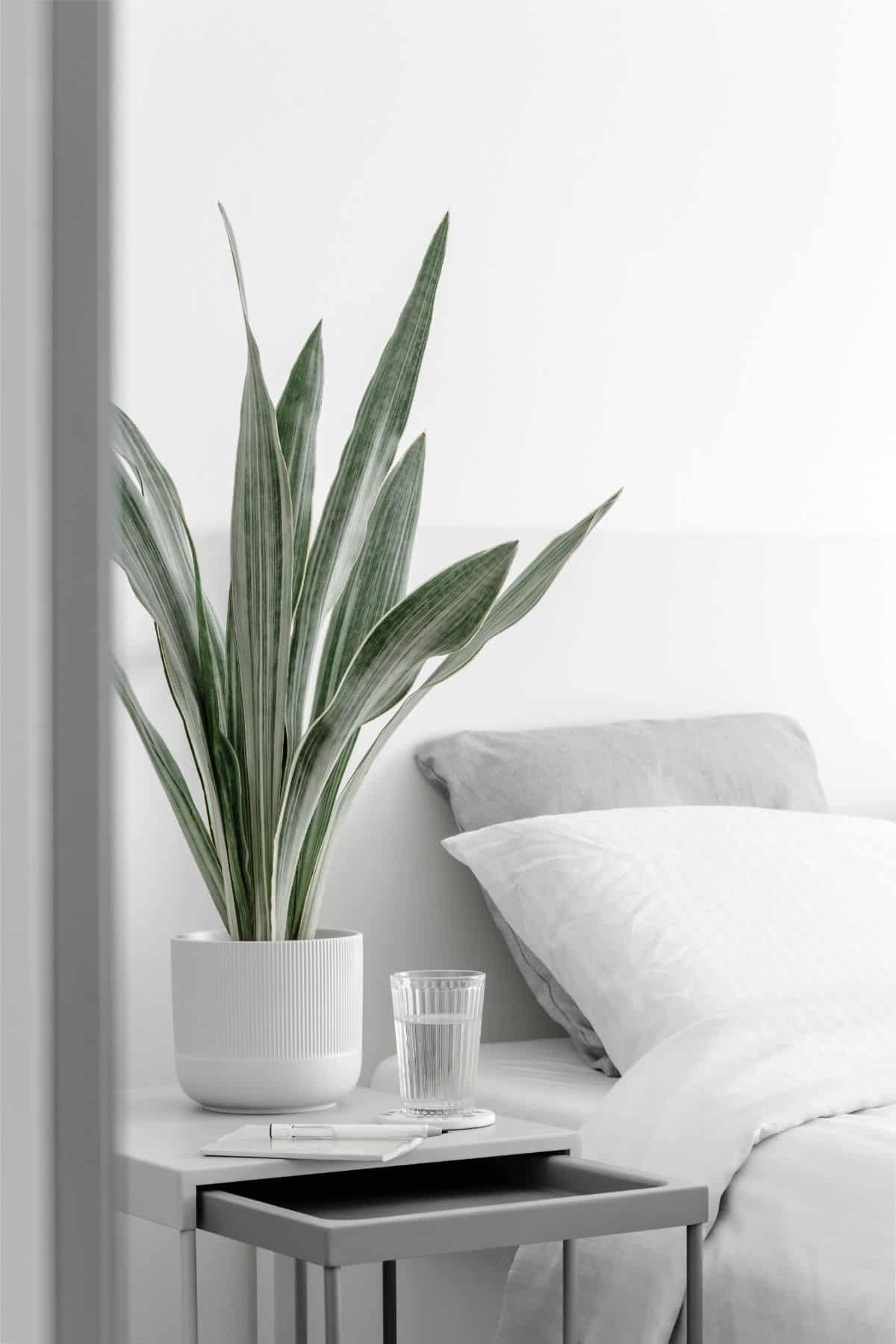
Buy it from:
I tend to find this species very attractive and kind of magical in many different ways. Rather than all of the strong colors that we see from most snake plants, we instead see a very pale green. With this species, it takes on a true silvery look; when you water and care for it properly, it will produce blooms under stress; however, you do need to make sure that they have enough space and fertilizer in order to bloom.
27. Sansevieria Moonshine

Buy it from:
If you're looking for size, beauty, and a little bit of an elegant touch to your room or to your garden, then you definitely want the moonshine. And no, I'm not talking about the drink. This species has very broad leaves that are outlined in a dark green pinstripe along the margins. The rest of the leaf is a very light green that, in some locations, can look rather white. This all depends upon the angle at which you're looking at the plant.
28. Sansevieria Obake
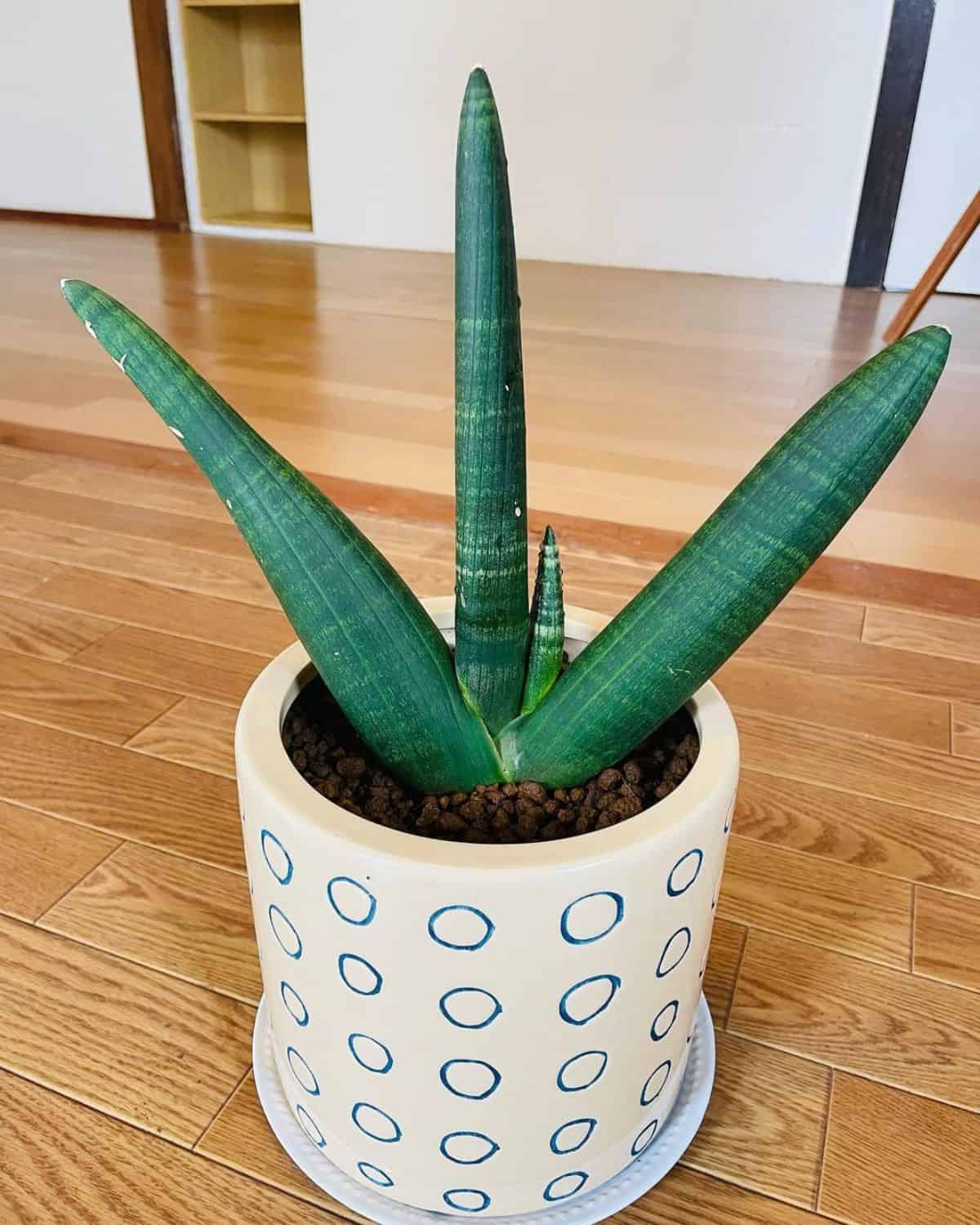
This type of snake plant is extremely interesting. Most of the time, individuals refer to this plant as a structure-creating plant in a room when you're designing. Because of how solid the cylindrical leaves are, they are able to withstand very dry dirt for a very long time. This species tends to get the name of an unkillable as a plant. There is a small amount of horizontal variegation, which also gives it a characteristic look. As perfect indoor plants, they only need minimal amounts of light.
29. Sansevieria Oncel Rhino
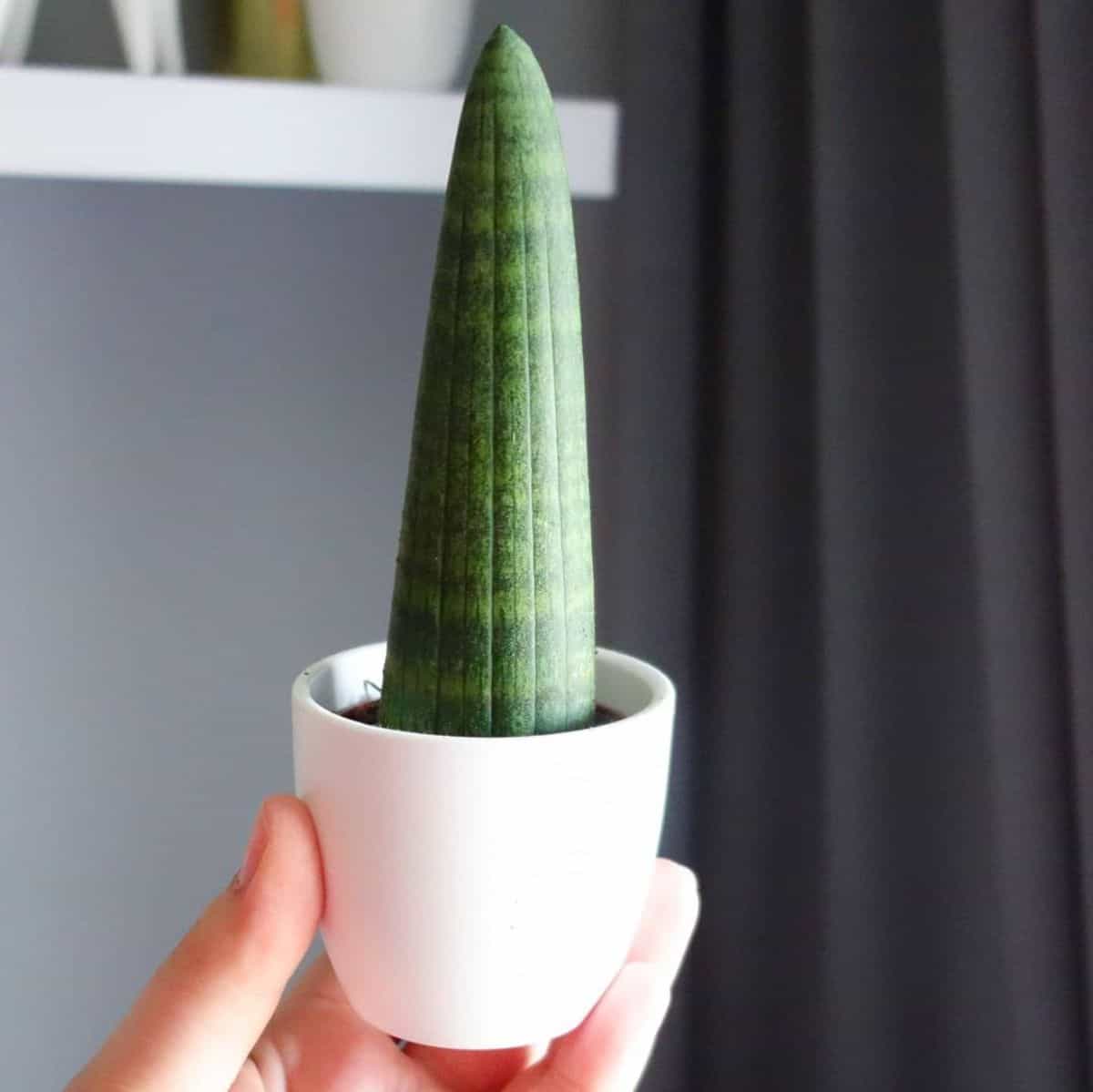
As they've seen before with some of the other snake plants, there are certain species that have cylindrical leaves as compared to flatter leaves. The rhino version is no different. Instead of the smaller leaves that we are used to on snake plants, this cylindrical leafed snake plant has massive leaves that truly resemble the horn of a rhino. They are horizontally variegated as well, which gives them an interesting allure.
30. Sansevieria patens
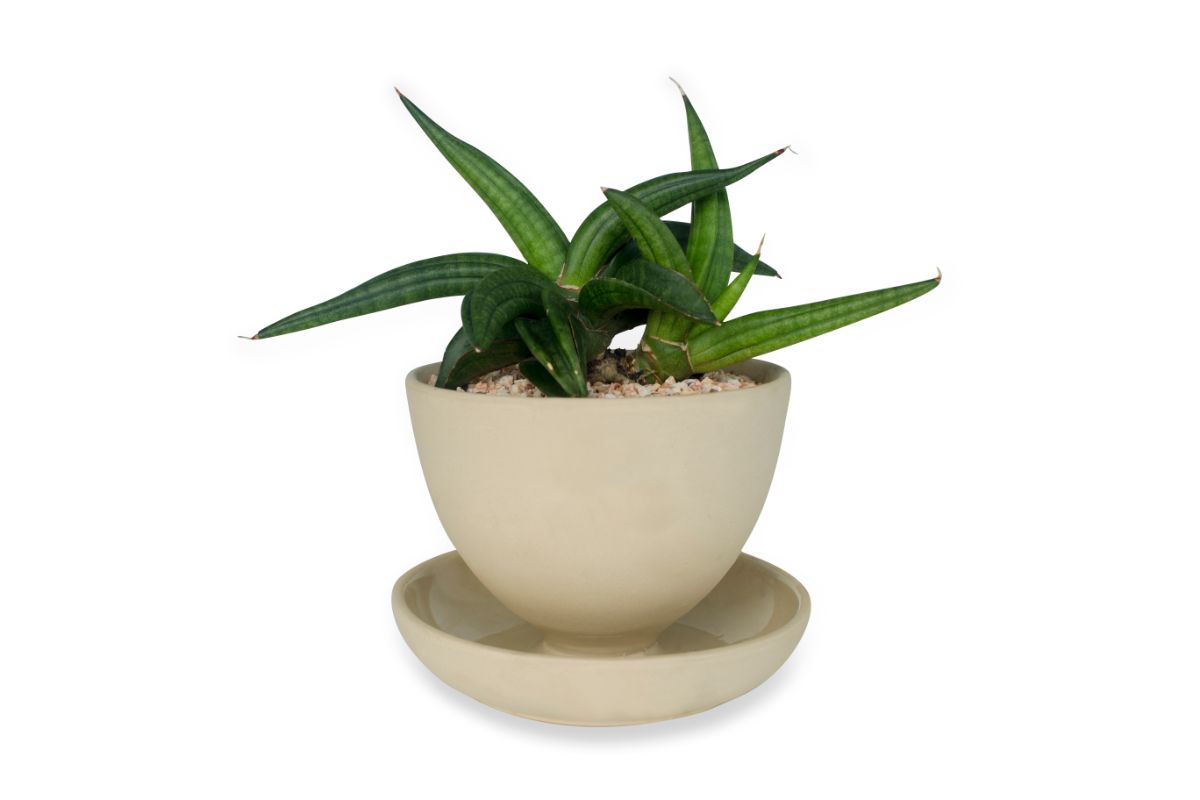
Buy it from:
This chunky Sansevieria is native to eastern Africa and grows in a rosette shape with short, cylindrical leaves. The grooved leaves can reach up to three feet long and about two inches in diameter.
They are typically dark green with light green bands. When in bloom, the plant produces clusters of grayish-white flowers.
As with other varieties of Sansevieria, Sansevieria patens grow best in moderately bright light. Brighter light will bring out the plant’s natural colors, but it can tolerate most light levels.
This plant prefers to be watered infrequently but deeply. It’s not frosted hardy and must be protected or brought inside during frigid weather
31. Sansevieria Pearsonii
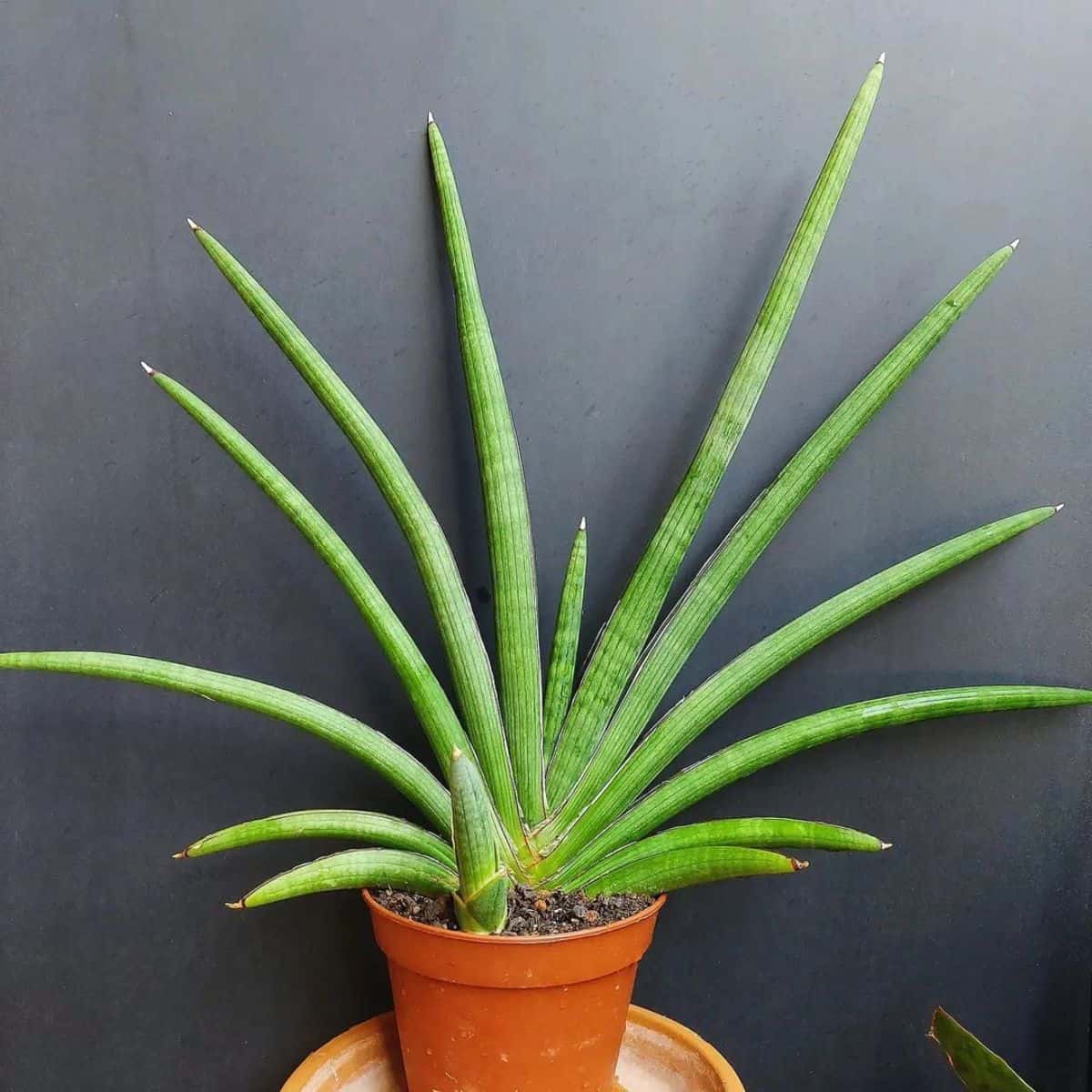
There are some snake plants that have very chaotic arrangements to their leaves. This species, however, tends to have a fan-like appearance with slightly curved and, again, very thick leaves. The variegation is vertical this time, and you can also see what looks to be like little ribs along the leaves as well. Again this is all in coloration, not in the actual texture of the plant. When in its proper conditions, this species will constantly grow in a proper fan shape.
32. Sansevieria Rorida
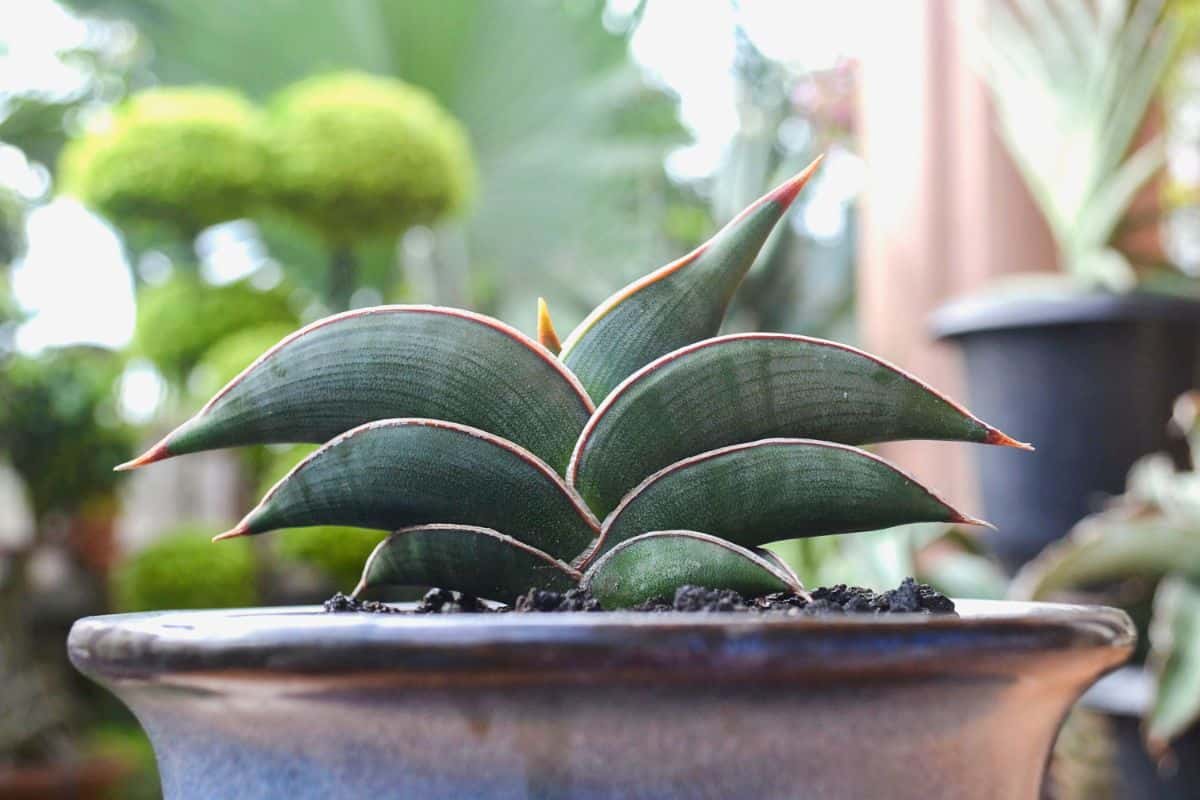
The shape of this species is very enjoyable. There's a dark maroon and light tan pinstriping along dark green leaves with slight variegation along the horizontal margins. The leaves fan apart in pairs, and they grow in the same direction instead of alternating. The leaves are heavily curved. These plants will offset by their rhizomes, which means that you can have a lovely collection of tightly gathered plants
33. Sansevieria Royal crown
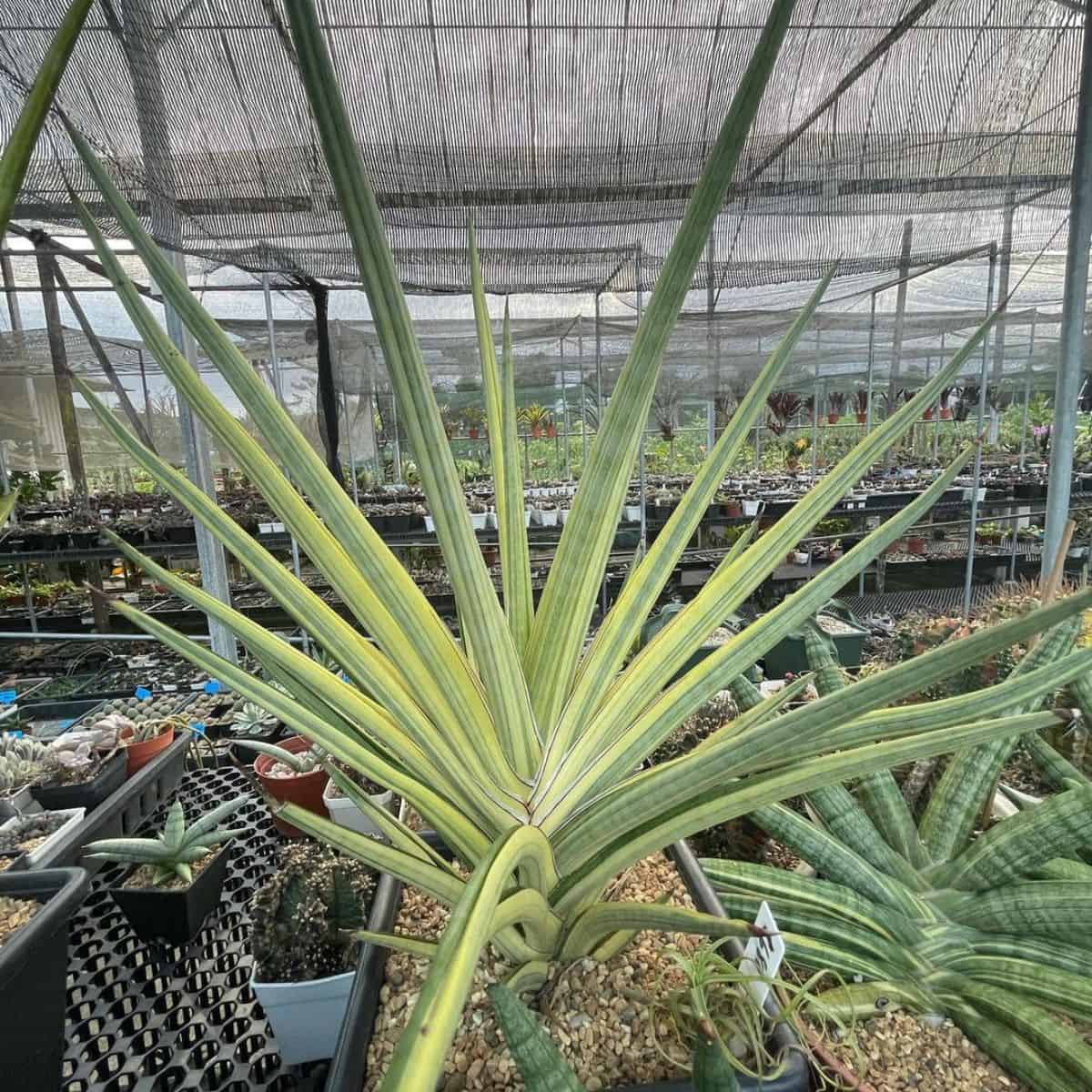
A young royal crown snake plant is definitely not as impressive as a more mature one. More mature royal crown plants have a beautiful array of leaves that stand straight out from their center. These leaves are very strong, thick, and slightly curved. They do end in sharp tips, and they can also come in a variegated pattern with yellows and greens. More often than not, they are light green with a slight dusting of what looks to be farina but is instead the coloration of the plant
34. Sansevieria Samurai dwarf
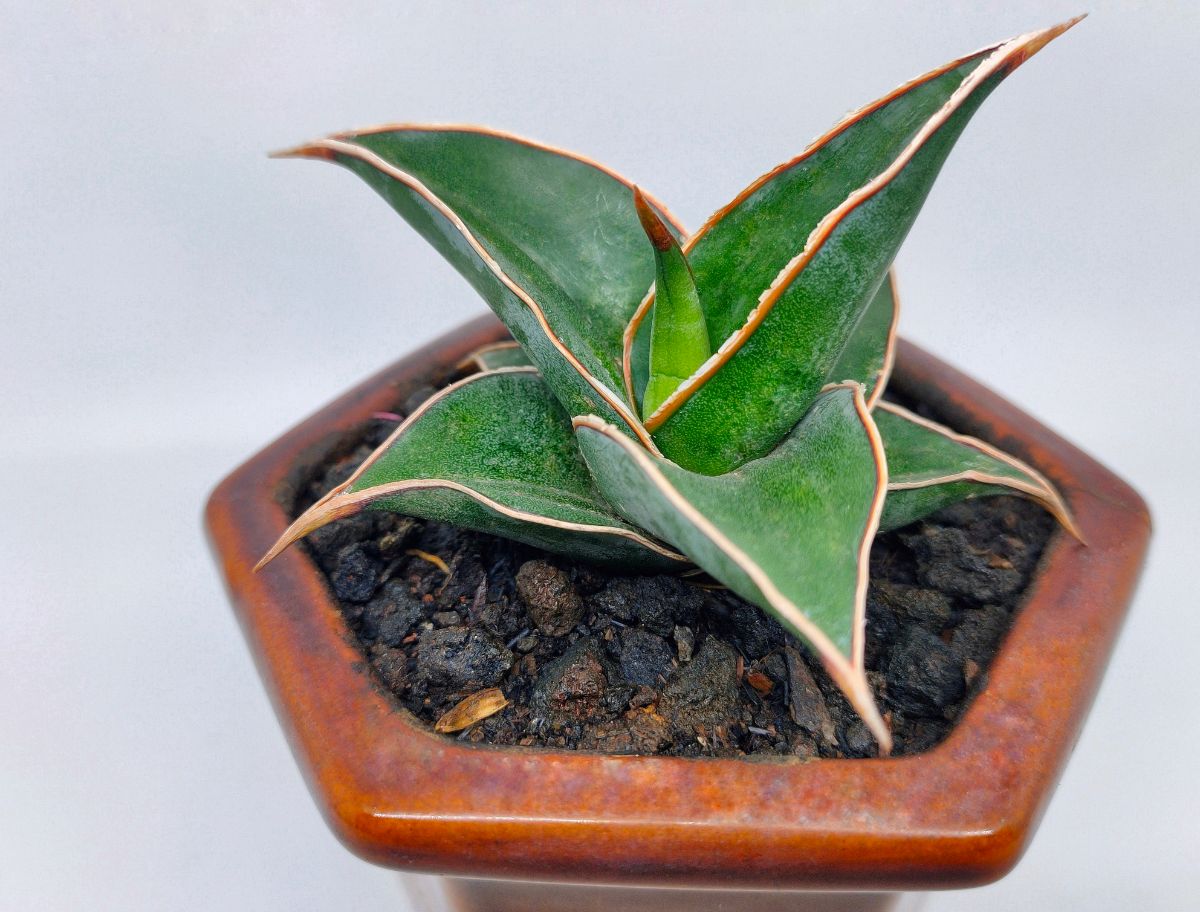
Buy it from:
This little beauty is often compared to bowls. The leaves themselves look as though you could pluck them from the plant and use them to scoop up water to drink. But don't do that! The leaves alternate while young, and as it gets older, they may eventually straighten out to where they alternate side to side as compared to perpendicular alterations.
35. Sansevieria Samurai dwarf variegated
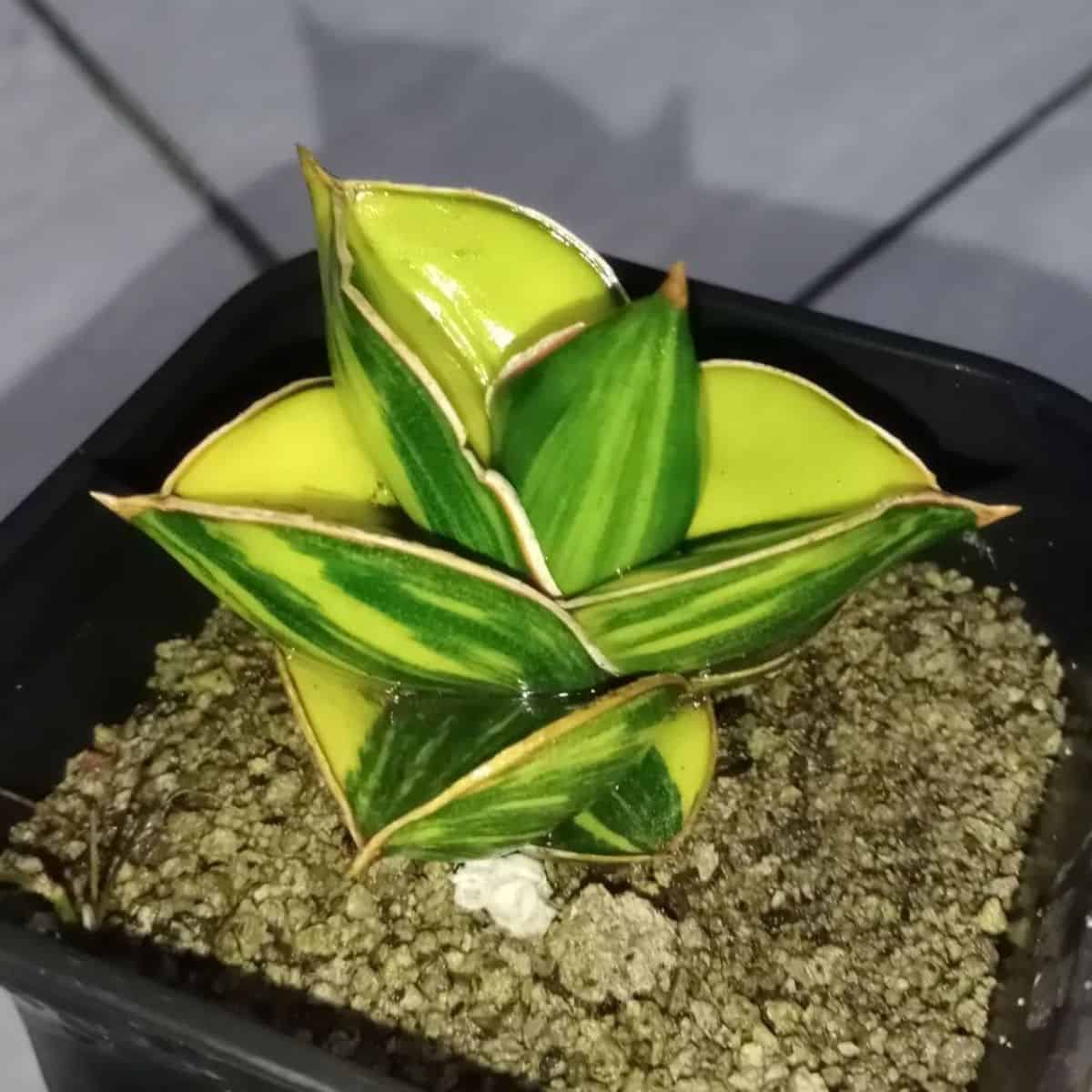
Just like the previous species, this is a variegated version of the same. One of the differences between the other two than the coloration is also the size of the leaves themselves. The variegated version can be somewhat undulate along the leaf edges, and the leaves can also be a little more narrow and slightly elongated.
36. Sansevieria Scimitariformis
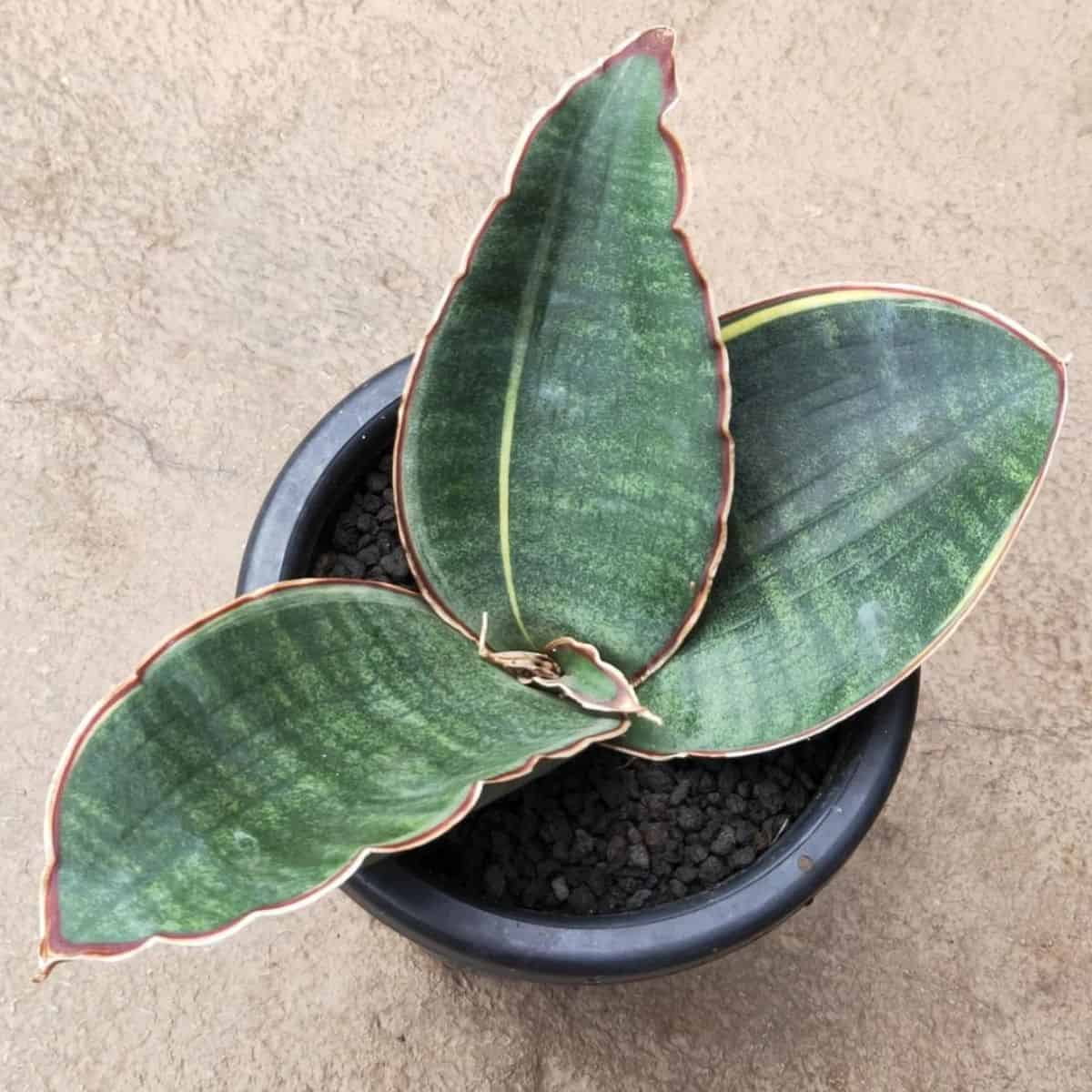
With this species, it's rather easy to see why it's named scimitariformis from a young age. The shapes of the leaves are very similar to that of a scimitar, and they are also vast blades of leaves that grow from a central rhizome. The flowers are rather interesting as they grow on stalks, and the petals crawl back to reveal stamens. Such an interesting way of growing!
37. Sansevieria Siam gold
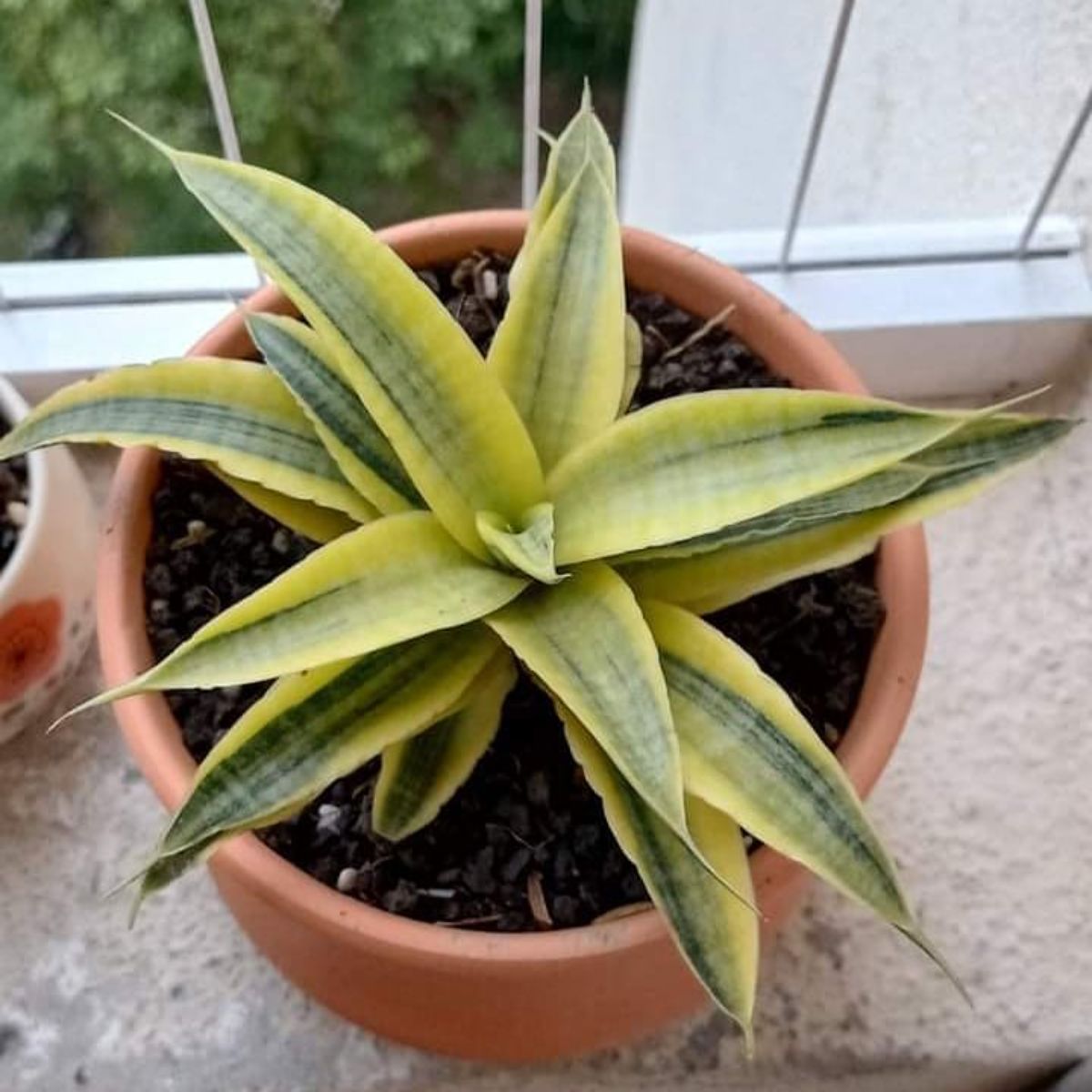
Another gold variation to add to your collection is the Siam gold. This species has a very interesting transition of patterns. Not only is it variegated, but most of the Siam gold species also begin to fade to a solid yellow towards the center of the plant. This gives it a very interesting effect of being drawn into the center of the plant.
38. Sansevieria Siam silver
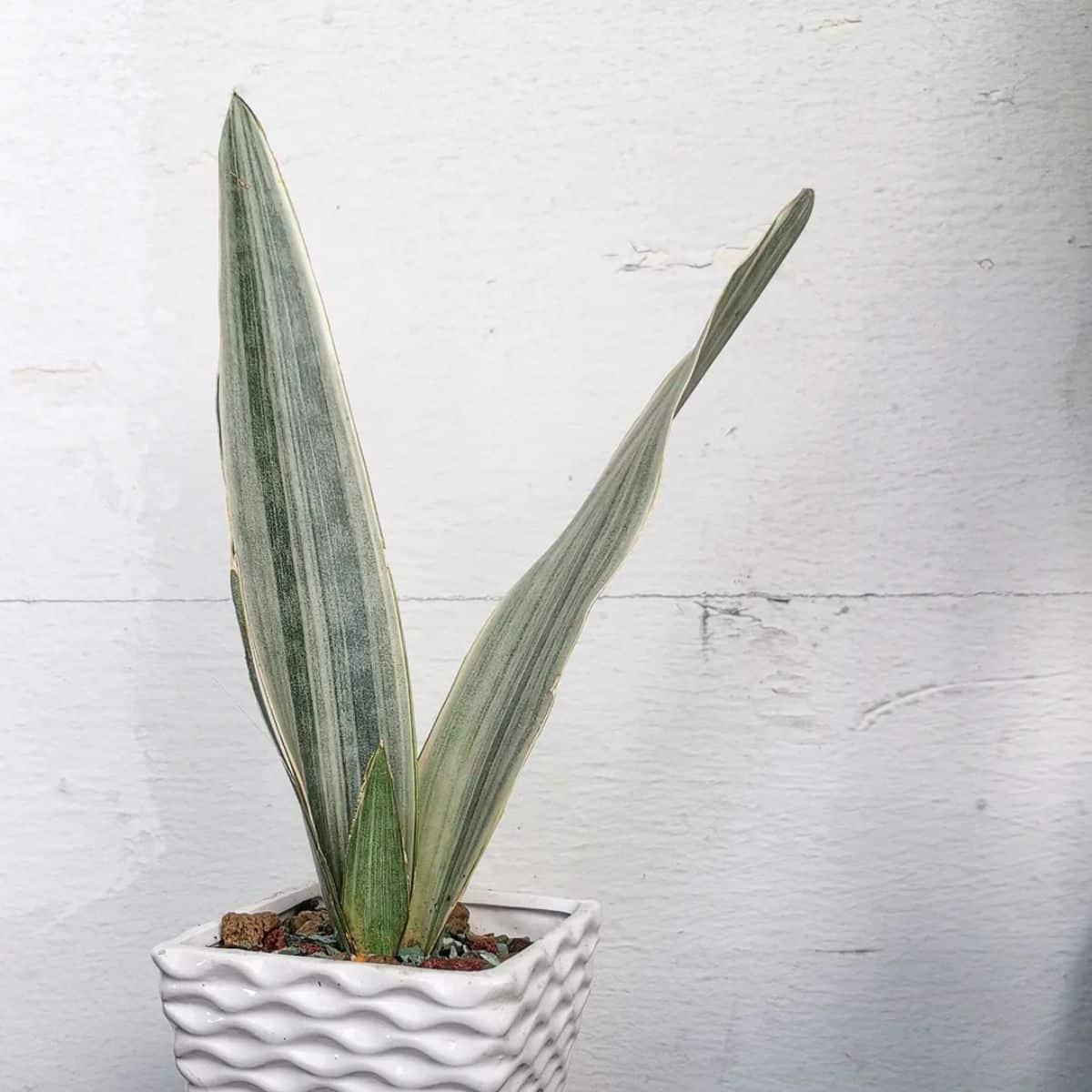
Just like its golden counterpart, the Siam silver is yet another species that is absolutely beautiful. Instead of a variegation of yellow, there is more of a white color to this particular species. While the white is technically a very light green, from a distance, it truly does look like a pale white.
39. Sansevieria Silver nymph
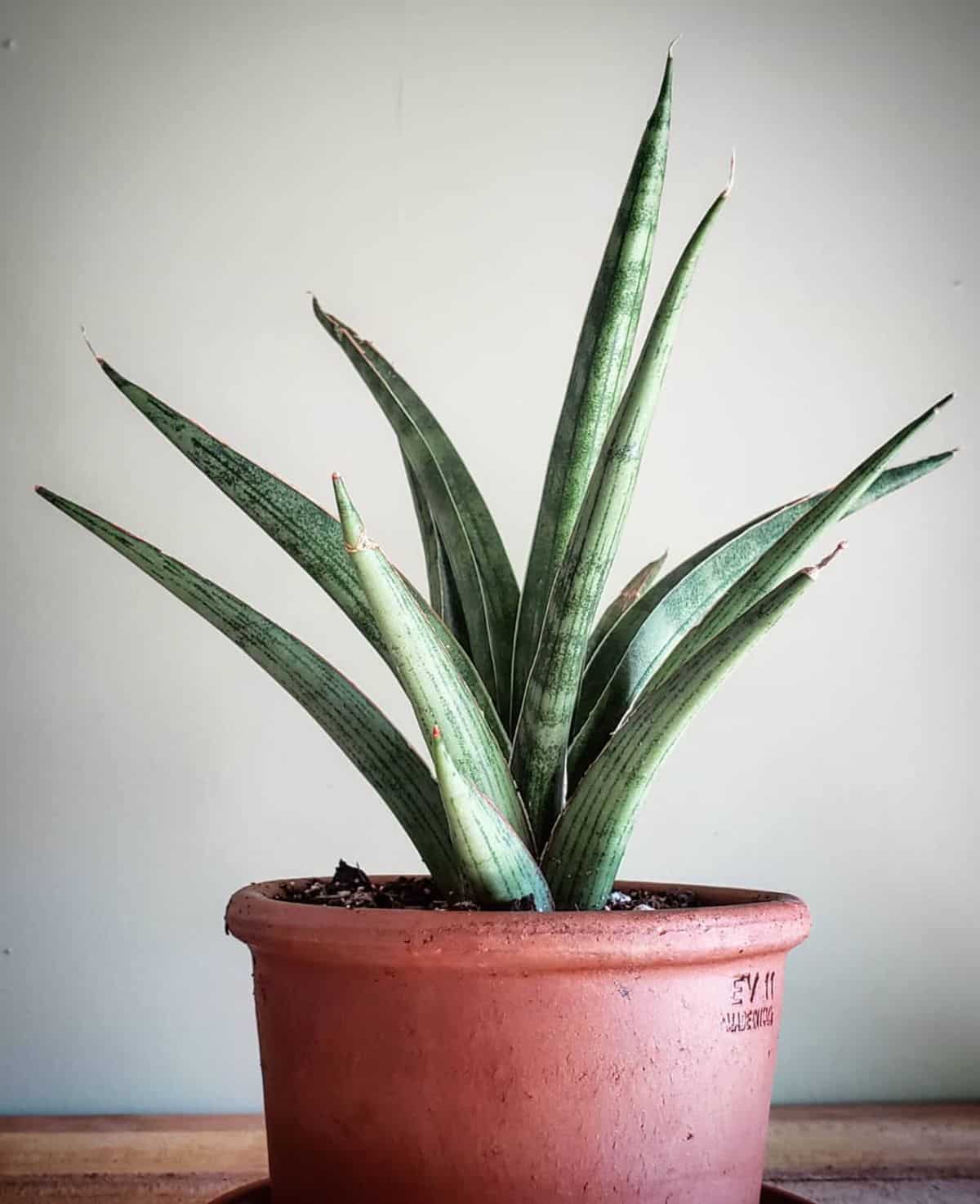
Well not exactly much to write home about; this species is known for its multiple leaves that grow in a wide array of shapes, sizes, and directions. They all go from a central rhizome, and that central rhizome is what yields offsets as well. There is some variegation along the edges, both horizontally and with splotches.
40. Sansevieria Star canary
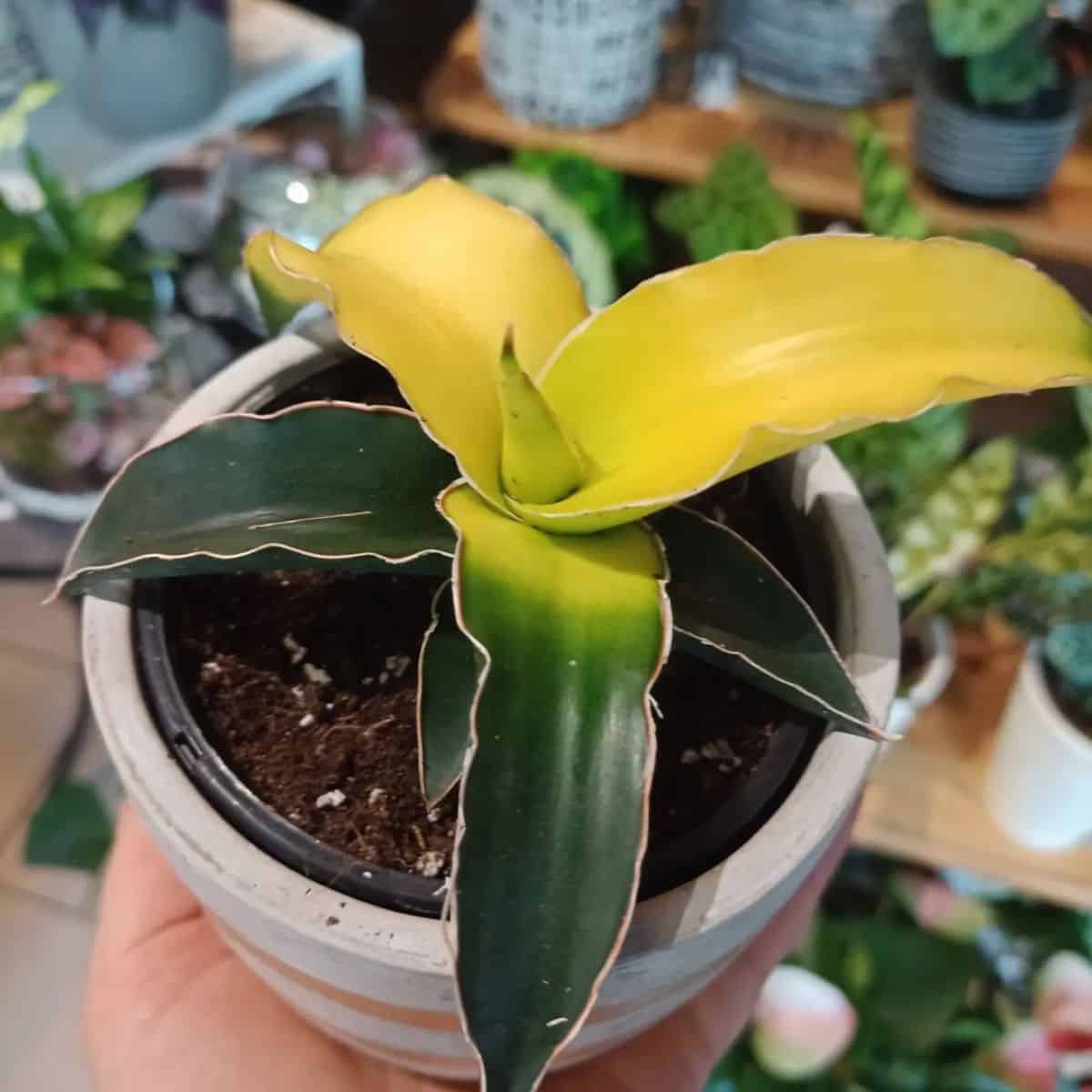
Buy it from:
For me, this is the showstopper piece. The stark nary is a truly splendid type of snake plant. They are right, almost banana yellow in the center, and as the leaves mature, that's when they begin to turn green. The leaves grow out of the center area and continue to follow this same pattern throughout the plant's life. Some leaves are also ungulate, and the leaves also tend to grow in opposite pairs.
41. Sansevieria Subspicata variegated
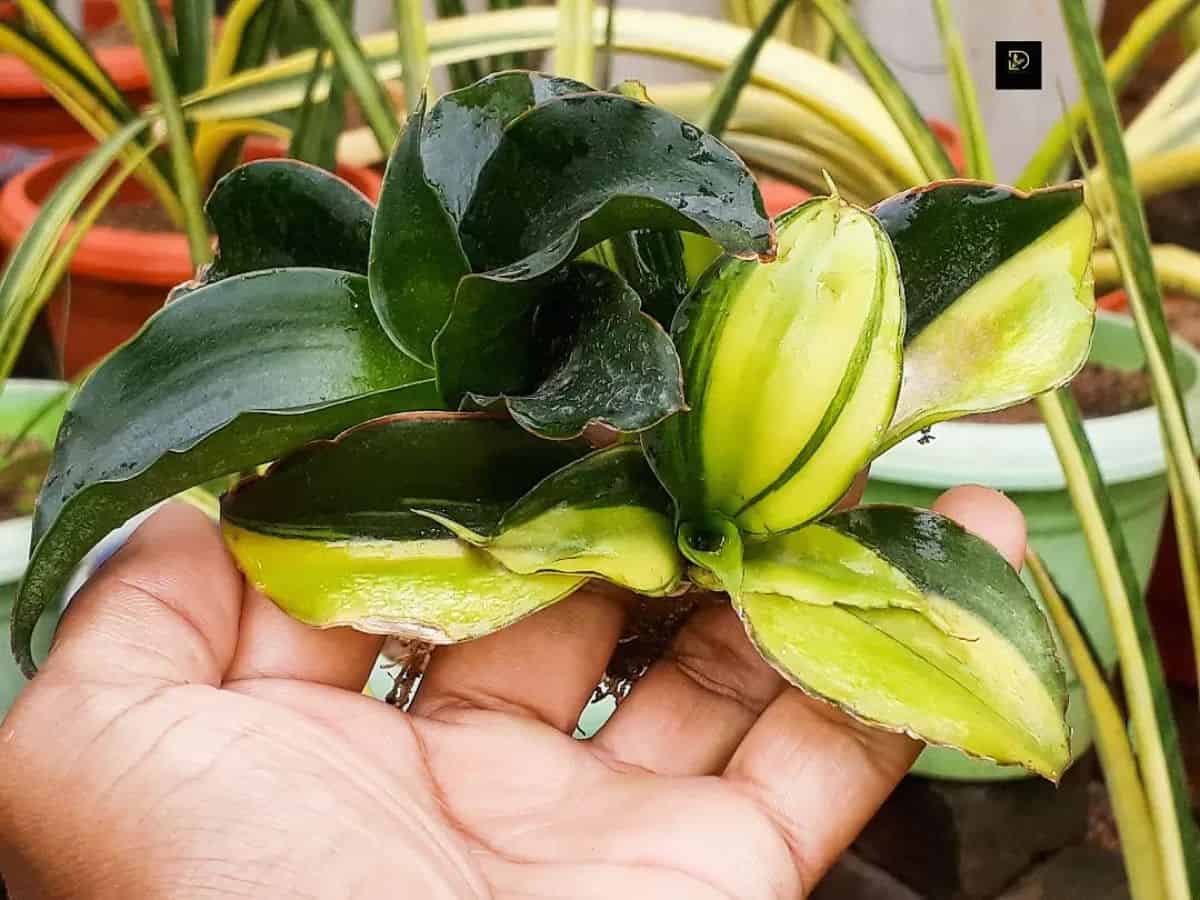
This is another kind of snake plant that is very similar to those that you'll often see at the grocery store. The variegation is vertical; this plant alternates between yellow and green stripes. They also grow in a typical snake plant pattern where the leaves grow from the center of the plant or the base ribosome.
42. Sansevieria Suffruticosa
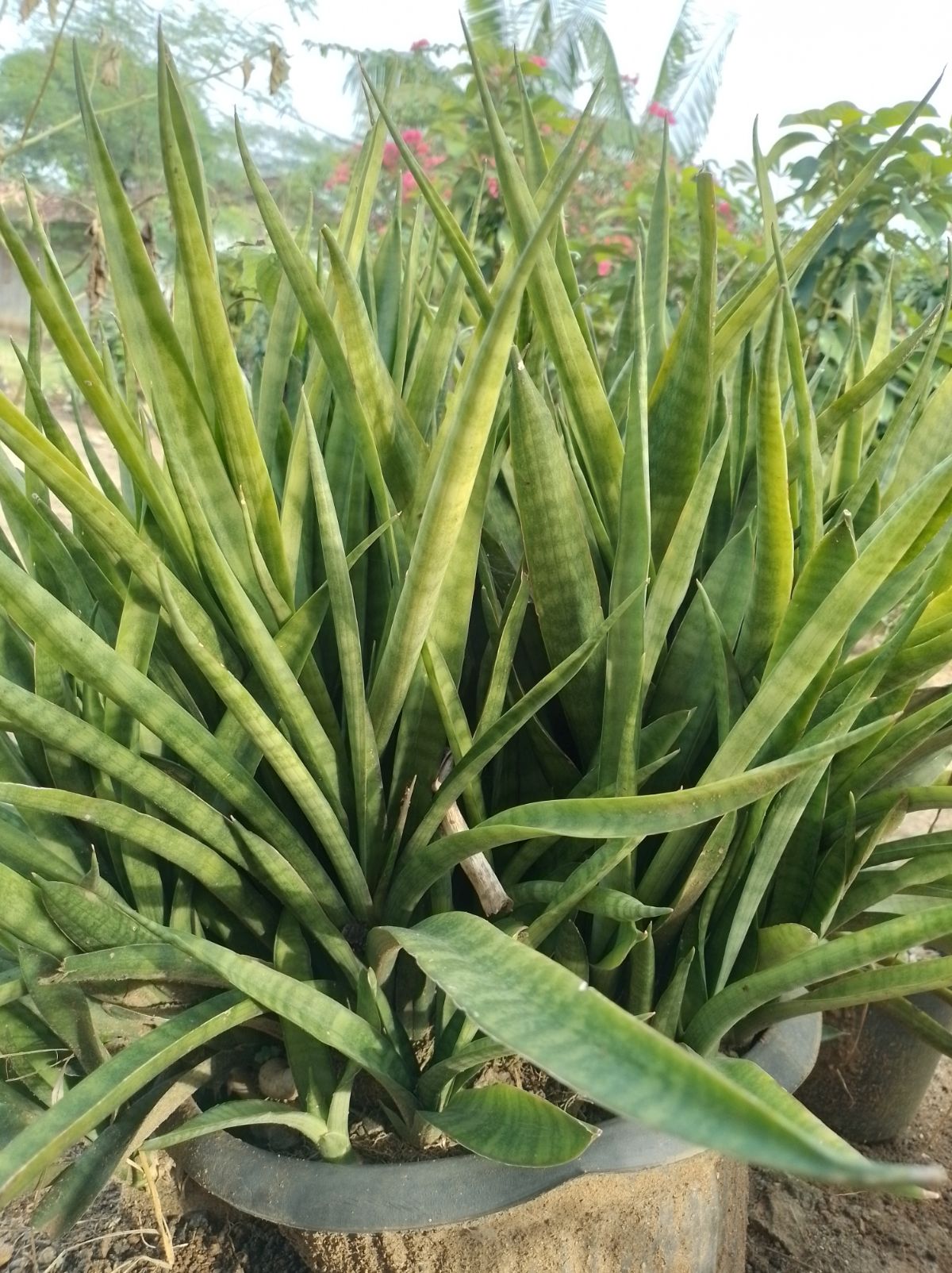
Snake plants are never going to stop surprising us. I've had to come to that realization. With this particular species, the base of the leaves are tunneled or canaled, but the end of the leaves are actually thick and closed off compared to the rest of the leaves; they propagate where are bright white stolons that are like silk propagating babies. Like other cylindrical sanseverias, this species also shows a great deal of variegation along the horizontal margins
43. Sansevieria trifasciata
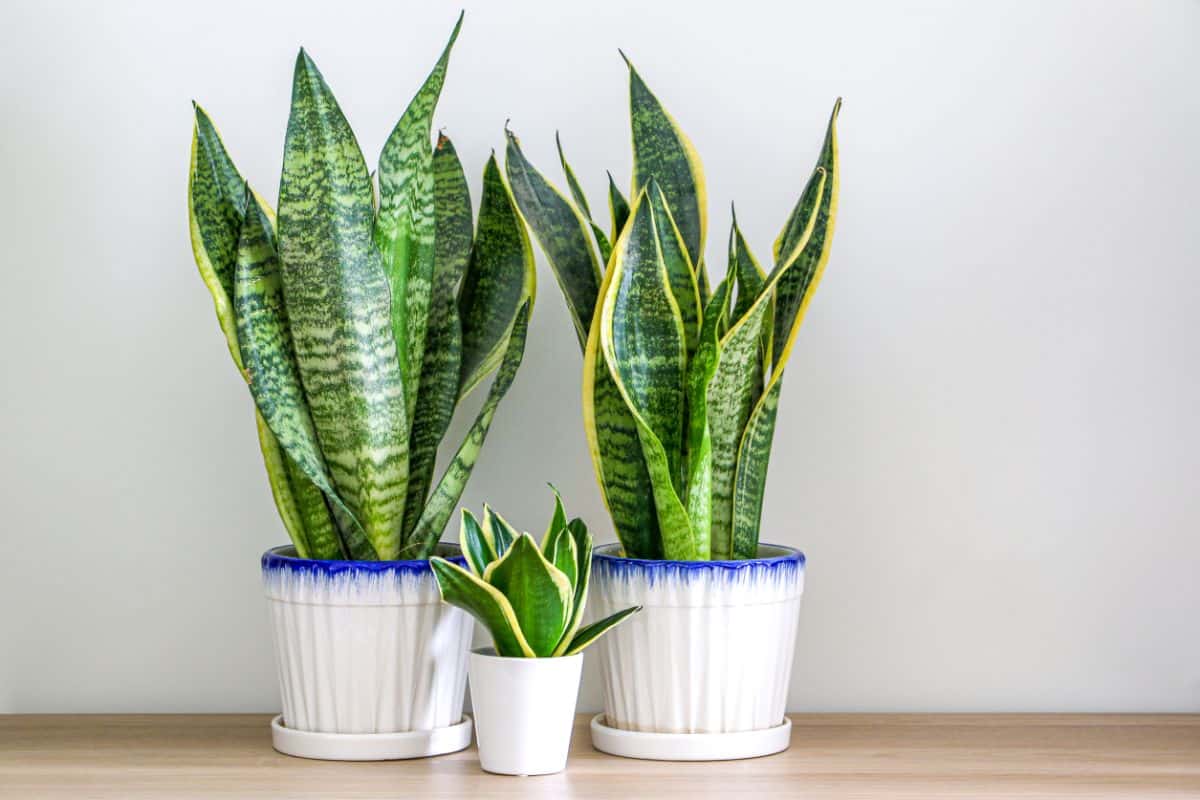
Buy it from:
Sansevieria trifasciata is one of the most common types of snake plant, and there are quite a few cultivars to choose from. Some have deep green leaves, while others have variegated or even curly leaves.
At maturity, the leaves are typically about three feet in length and 2.5 inches in width. This plant is native to West Africa and is a popular choice for landscaping or as an accent in indoor décor.
Sansevieria trifasciata is easy to care for plant and is a great choice for beginners and experienced gardeners alike.
It requires moderately bright light but can survive in low-light environments. It prefers well-draining soil, as too much moisture can cause root rot.
44. Sansevieria Trifasciata gold hahnii
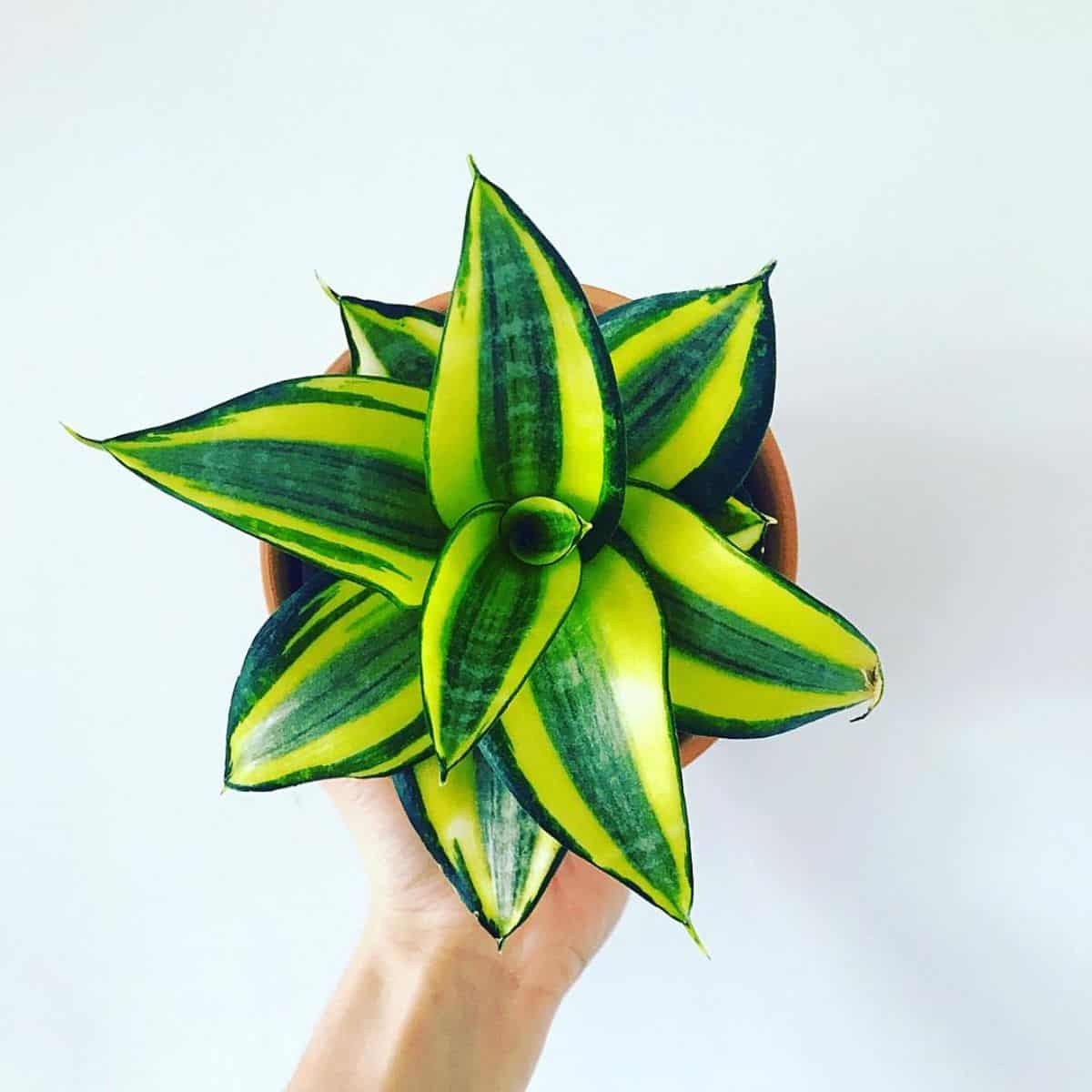
Buy it from:
We've already chatted about a few of the bird's nest snake plants; this is another favorite pick for many gardeners. The Gold Hahnii, has the traditional variegation that gives a snake plant that snake plant look. Well, it is not as golden as the golden Wendy; the yellow does tend to have that very strong buttery appearance to it
45. Sansevieria trifasciata ‘Laurentii’
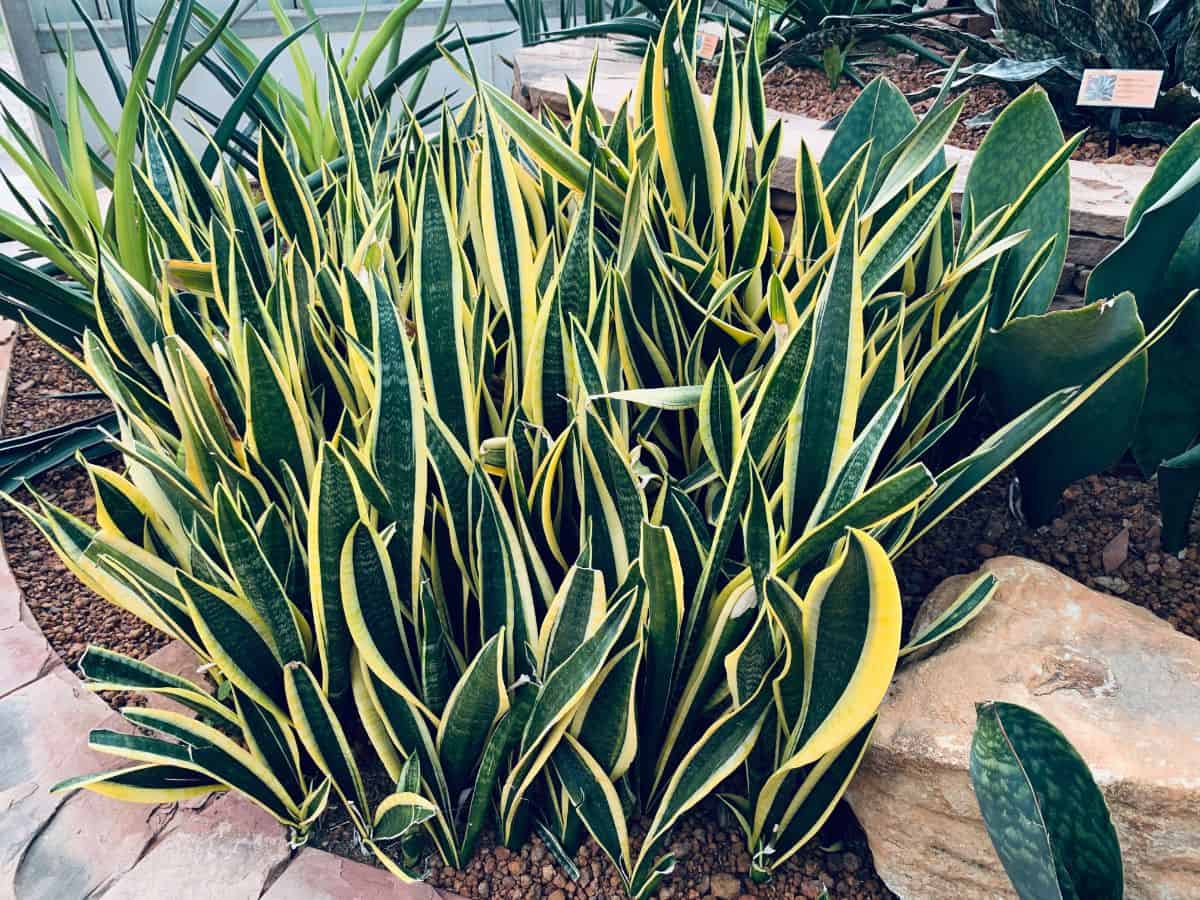
Buy it from:
This variety of Sansevieria features deep green leaves with golden edges. At maturity, the plant can reach up to four feet tall.
Like other Sansevieria, the sword-shaped leaves grow vertically in a tight clump. It’s rare for this cultivar to bloom, but when it does, it produces greenish-white leaves at the top of a slender inflorescence.
Laurentii does best in moderately bright light. Brighter light will result in more vibrantly colored leaves, but the full sun may burn the leaves. This plant does best with infrequent water, especially during the winter. Well-draining soil is essential in preventing root rot.
46. Sansevieria Twist
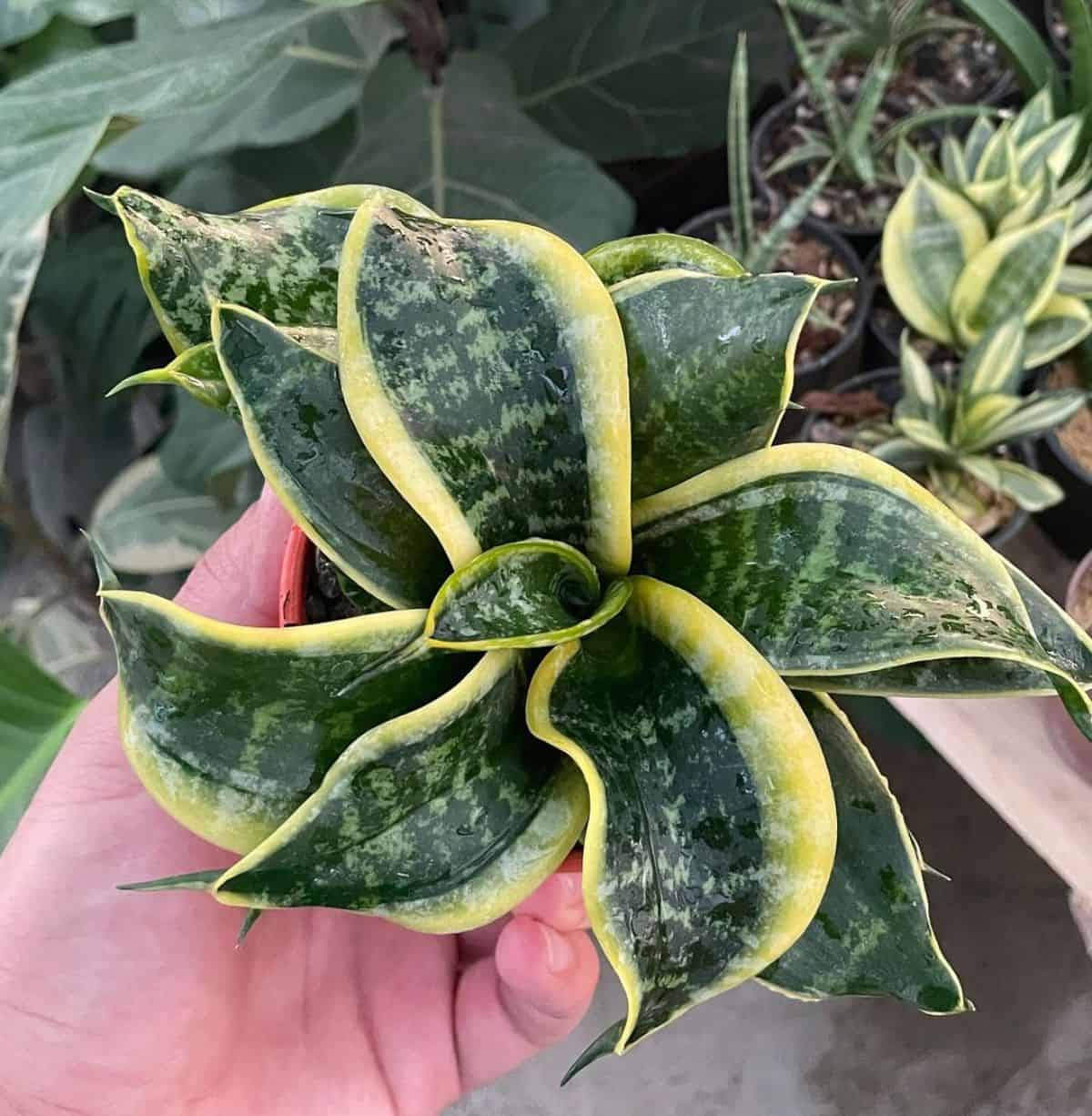
Also known as the Twisted Sister, this is a quintessential snake plant with a legitimate twist. Instead of the leaves growing straight up, they can grow at several odd angles due to the way the leaves twist. They are green in the center, and the green is mottled and or variegated, and the outer margins of the plant are a bright golden yellow.
47. Sansevieria Whitney
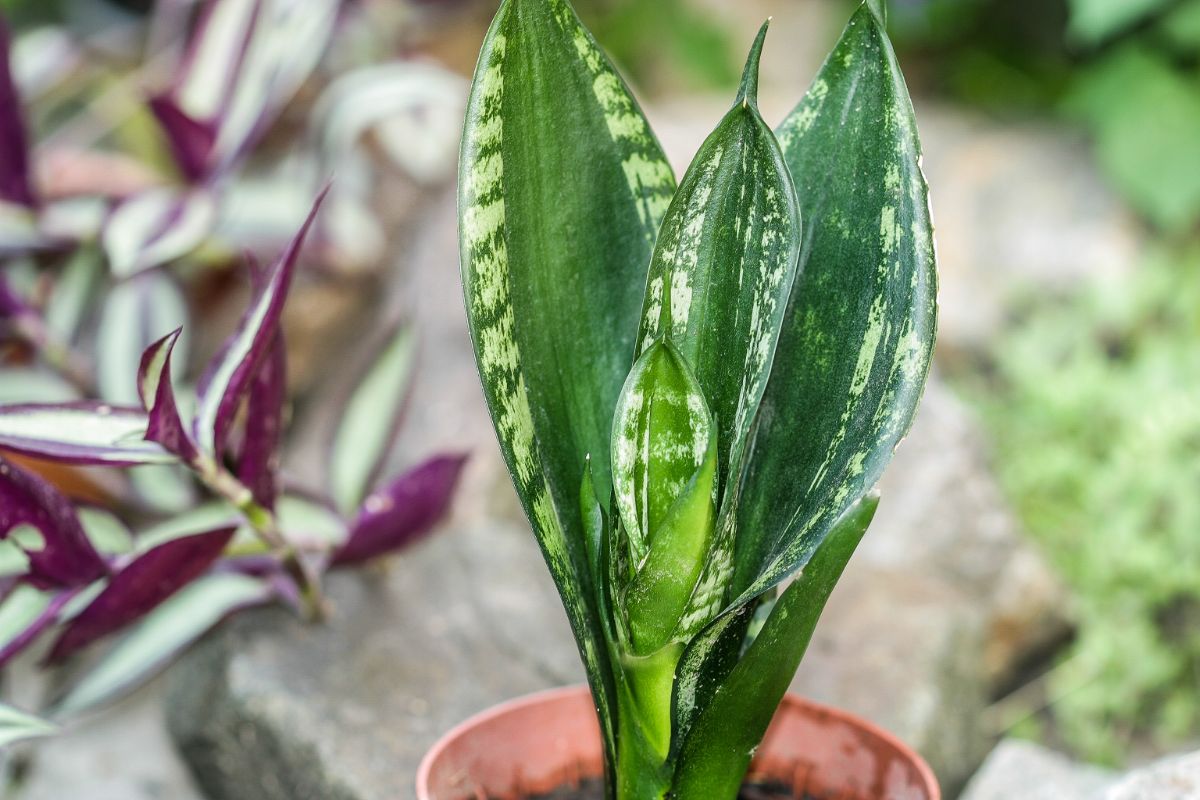
This one I found to be interesting because it is such a reverse from what we commonly see. More often than not, we see a solid color along the outer edges of the plant and a more variegated color toward the center of the leaf. Instead, with the Whitney variation of the snake plant, we have a solid green stripe down the center of the leaves with variegation along the outside of the margins. It does look like speckling or striping; this can also vary from plant to plant.
48. Sansevieria Zaznibarica robusta
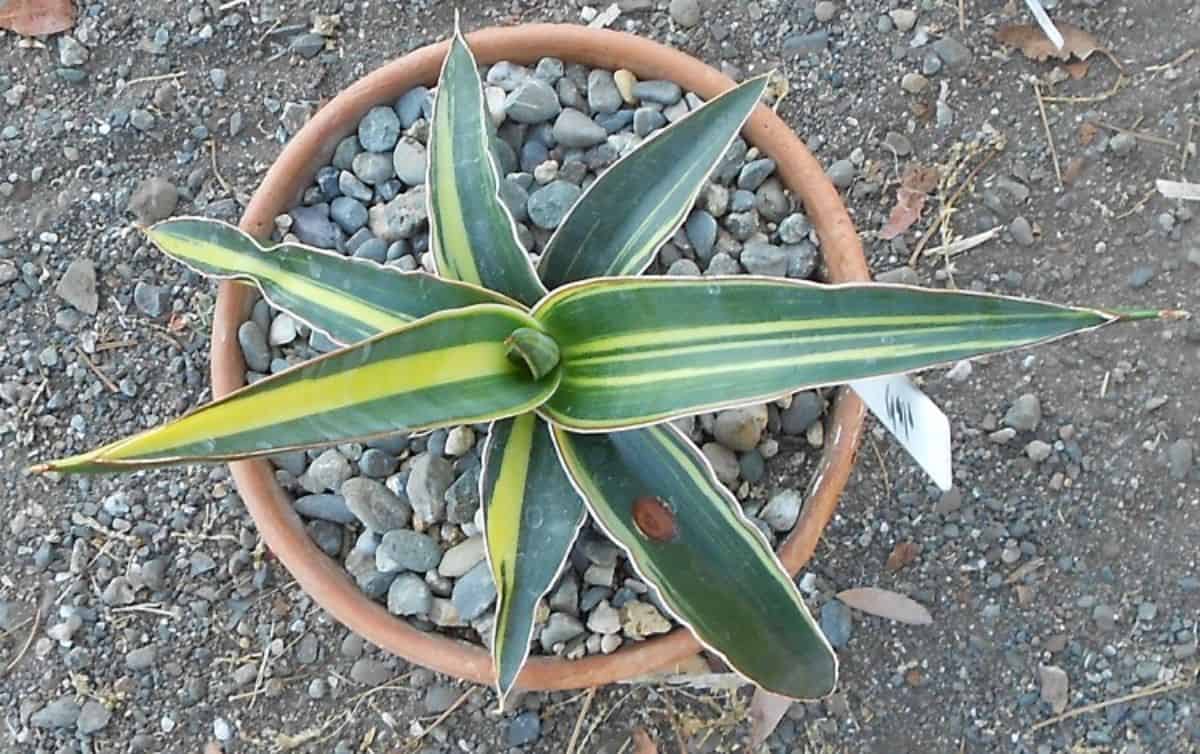
A specific species that is a little hard to find, this snake plant shows interesting characteristics throughout its aging process. At first, it starts as a dark green or a very light green infant period. From there, it begins to darken, and as new leaves appear, they, too, will darken as they mature. However, as young leaves, they remain yellow and green variegated leaves. The green that's on the variegated ones tends to be more of a lime type of color rather than the dark green that we're used to seeing with most snake plants.
49. Sansevieria Zeylanica
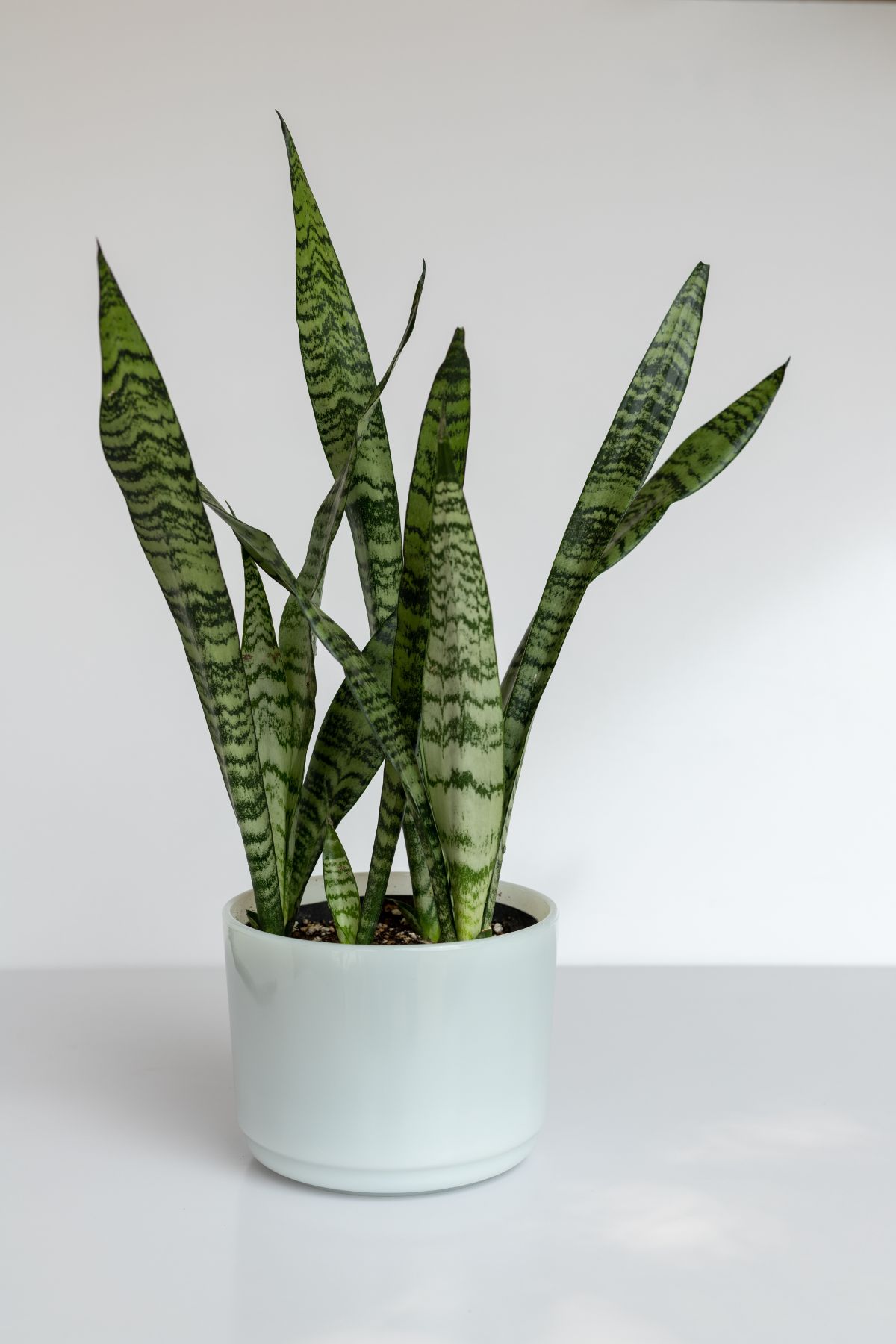
Buy it from:
Last but certainly not least, this variation of the snake plant has an extremely beautiful pattern of strong white variegation with very dark green variegation. These stripes are horizontal as compared to vertical, and the leaves do follow the same typical sword-like shape. These leaves are thick, but they are not going to be as curved as others. Younger versions of this plant may show thicker leaves with some curving; however, as they mature, the leaves will begin to thin out and take on the traditional snake plant appearance.
Snake Plant Buying Guide
When looking for your next snake plant, you want to purchase something that is going to grow luscious for years to come. It isn’t as easy as it sounds to buy a snake plant; you have to consider which types of snake plants are suitable for you and which one you like the look of the most, along with many other factors. Take a look at the following buying guide for advice.
Color
A plant’s color is a big indicator of its health. Discoloration can be a sign of many conditions, some more serious than others.
Snake plants should be bright and vibrant. Their leaves should be a rich green color, and their stems should look vibrant and crisp. Watch out for signs of yellowing or spots of black or brown, as this could be a sign of a very serious condition.
Texture
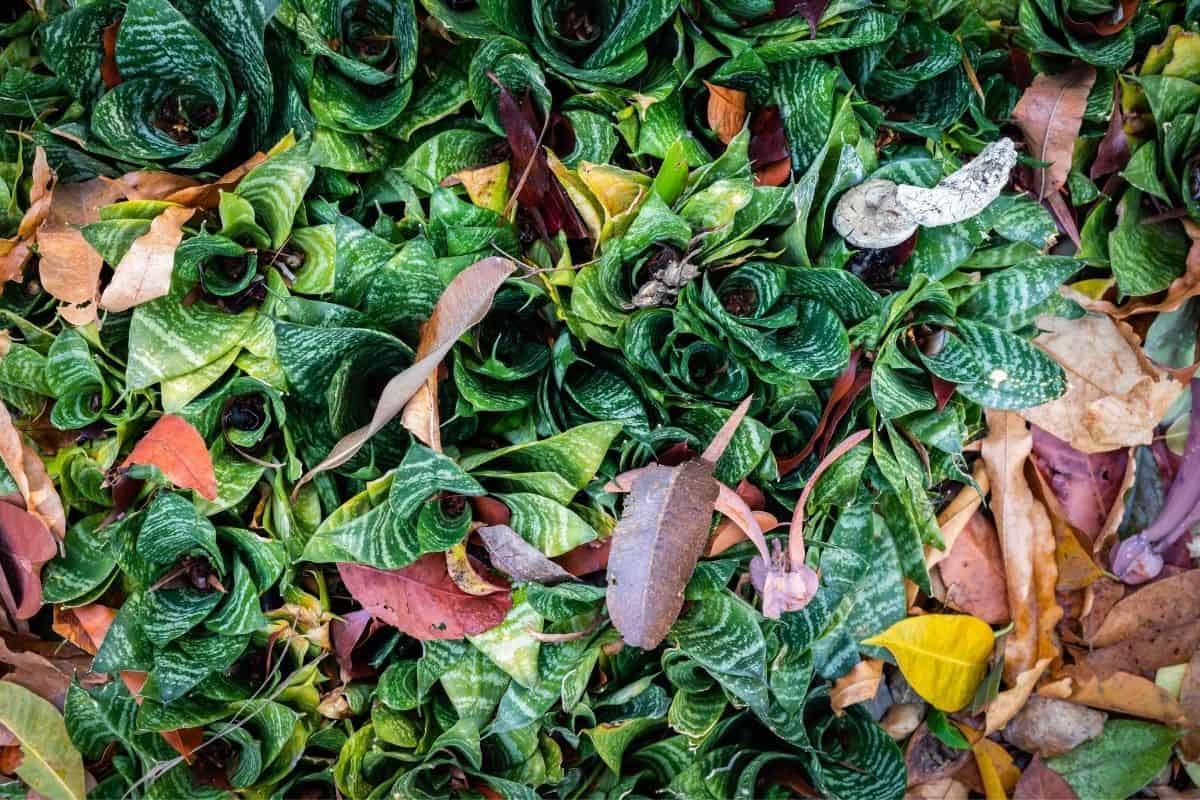
The plant’s texture is a very important indicator of its health. Snake plants should have firm stems, and their leave should be crisp and keep their shape.
Soggy leaves or stems or a floppy-looking plant are a bad sign of plant health. Flimsy stems and soggy leaves could be a sign of root rot, which is a very difficult condition to overcome.
Root System
If you are purchasing the plant from a garden center and not from an online store, you should remove the plant from the pot and inspect its root system. This shouldn’t be a difficult task.
If the soil and the roots stay tightly packed and keep the shape of the pot even when the plant has been removed from the pot, then the plant has well-established roots. If the soil crumbles away and leaves you with a load of dirt in your hand, then the root system is not established.
Pot
The pot a snake plant is planted in can always be changed, so don’t base your final decision on the look of the plant’s pot. Make sure that the pot has plenty of drainage holes in it for the excess water to escape from. Terra cotta pots are great for snake plants.
Snake Plant FAQ:
Are you looking for more information on snake plants? That is where the following frequently asked questions section will come in handy. Read through the section below to discover more about snake plants now.
Is there a snake plant called ‘mother-in-law’s tongue’?
Yes, there is! The sansevieria trifasciata is also known as ‘mother-in-law’s tongue’. It is one of the most popular species of snake plants, and many people choose it for their home due to its hardy nature and low maintenance.
How many types of snake plants are there?
There are about 70 species of snake plants around! No wonder choosing a snake plant for your home can feel like a challenge!
Should you fertilize a snake plant?
Snake plants are slow-growing plants that do not require fertilizer. You can use fertilizer if you want to give your plant a boost, but this is not recommended if you are unfamiliar with using fertilizers, as using too much will kill your plant.
What do snake plants symbolize?
Keeping a snake plant in your home is symbolic for many reasons. It symbolizes cleanliness and positive energy.
Are snake plants hard to maintain?
No, snake plants are very low-maintenance plants. They don’t require fertilizer, and they need very little water to survive, which is great for people that love the idea of having plants in their homes but hate having to fuss over them constantly.
Why is my snake plant leaning?
Overwatered snake plants will start to droop down or wilt, which could cause them to lean. Another reason your snake plant might lean is due to insufficient sunlight. Your plant might be leaning towards the light source to get as many nutrients from the light as possible.
How quickly does a snake plant grow?
Snake plants grow slowly when grown indoors, so you’ll expect the snake plant to grow only about a few inches every season. You’ll also notice only about two to four additional leaves. In comparison, they can grow more rapidly outdoors, especially during summer. How tall and wide they’ll be will depend on the specific variety of the snake plant.
Can you plant different types of snake plants together?
Known as companion planting, planting plants with similar growth requirements together or close to each other has a lot of benefits. Mostly, people grow a plant species with insect- and pest-repelling properties next to another to protect it from infestations. However, you may also do so for aesthetics and other purposes.
That said, you can plant two or more snake plant varieties together, whether variegated or non-variegated. Just make sure you use a large enough container or pot, as they’re slightly root-bound.
How long does a snake plant live?
As a tough plant variety, the average lifespan of adequately cared for and nourished snake plants ranges from five to 10 years, but some can live on for 20 to 25 years.
Conclusion
Well, there you have it! 49 out of the 70 available snake plants that we know of today. It's a lot to learn, and it's a lot to see, but hopefully, you enjoyed looking at pictures of absolutely gorgeous succulents and reading a little bit about their history and how we describe what they look like. If you have any questions about these species or if you have one that you would like us to add in, go ahead and comment below!



Elika
Saludos. Tengo una sansevieria pero no le sé el nombre. He buscado y buscado en internet y nada. Si pudiera a través de un correo electrónico anejarle 2 fotos para que la aprecien y puedan ayudarme a conocer su nombre. Gracias!!
Suzi Jones
Great article! I live in northern Michigan and I can't find local or mail order sites that sell the unusual variety of snake plant. Any suggestions? Thx?
Tracy
Try Planterina or Pistils Nursery.
Sudeep
Wow, i had been looking for the names of all the different snake plants i have in my garden.
Do they all have common names as mother in law's tongue.
Its very hard to remember those names and even tell others about it